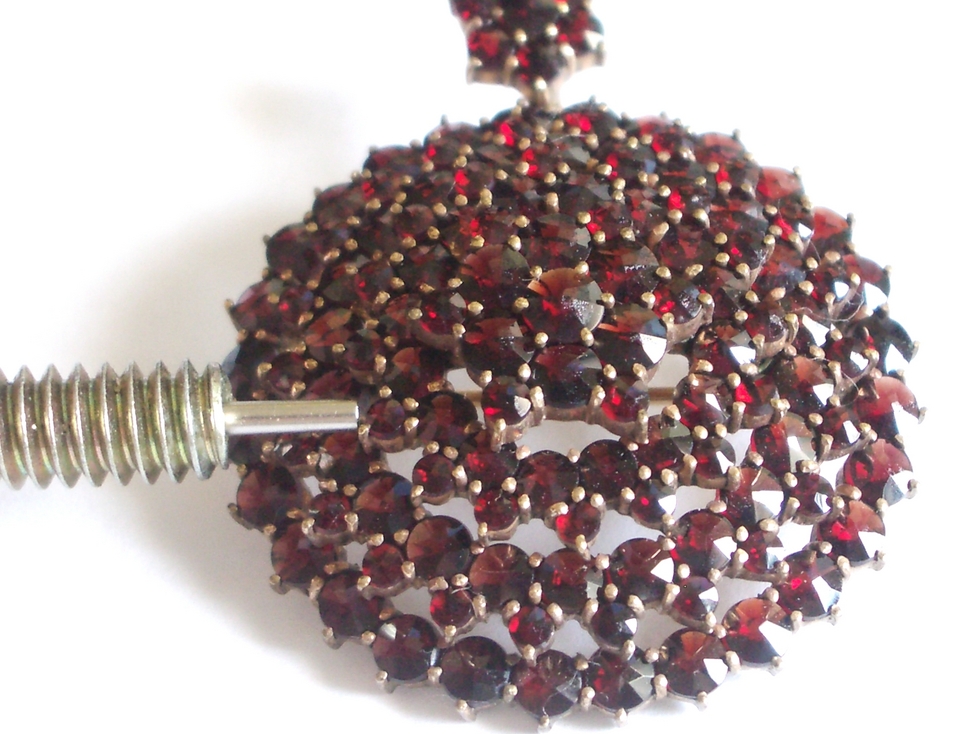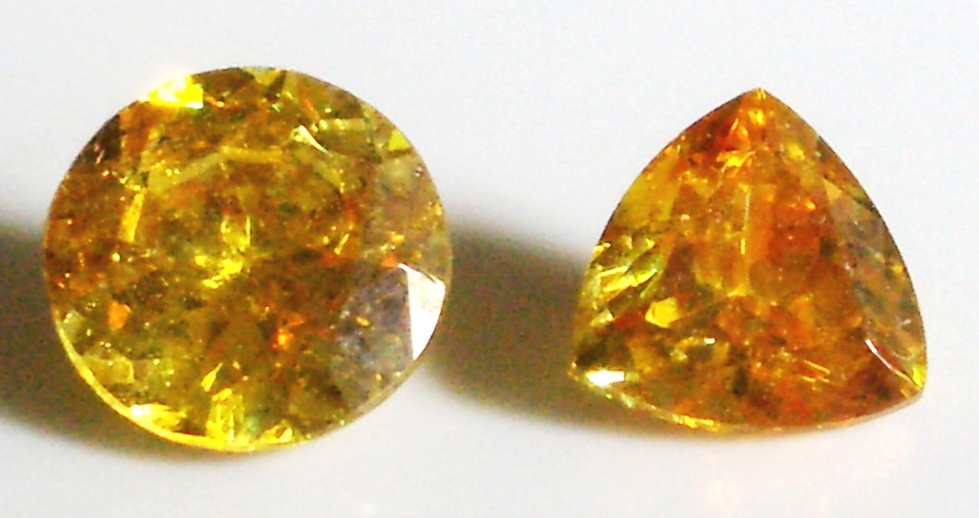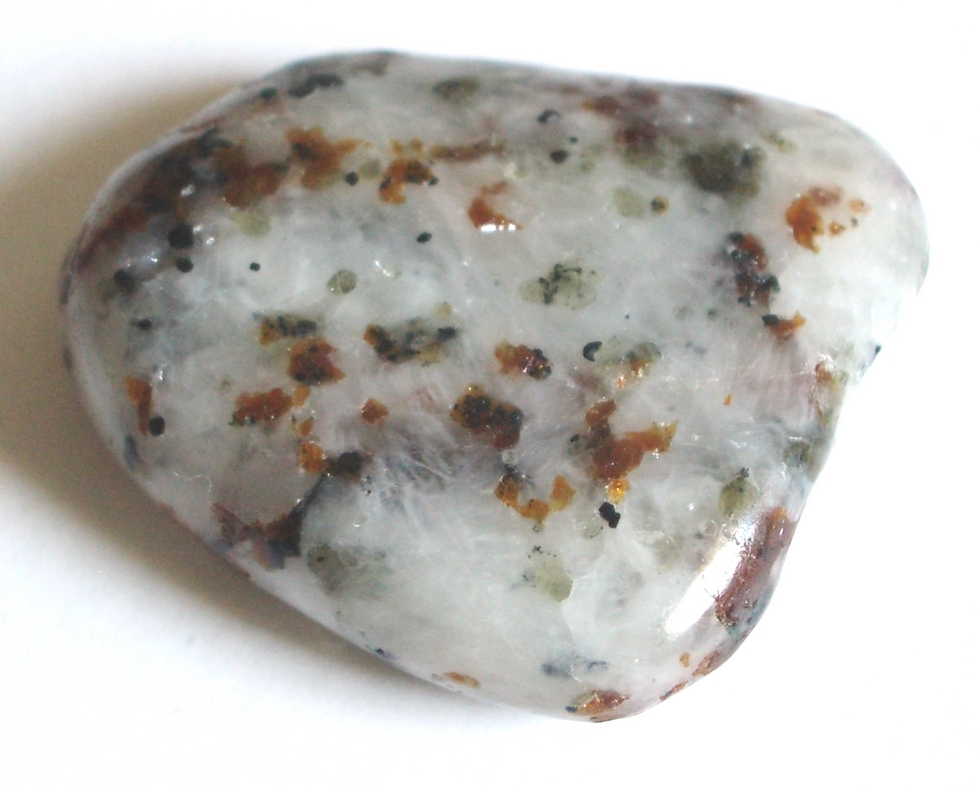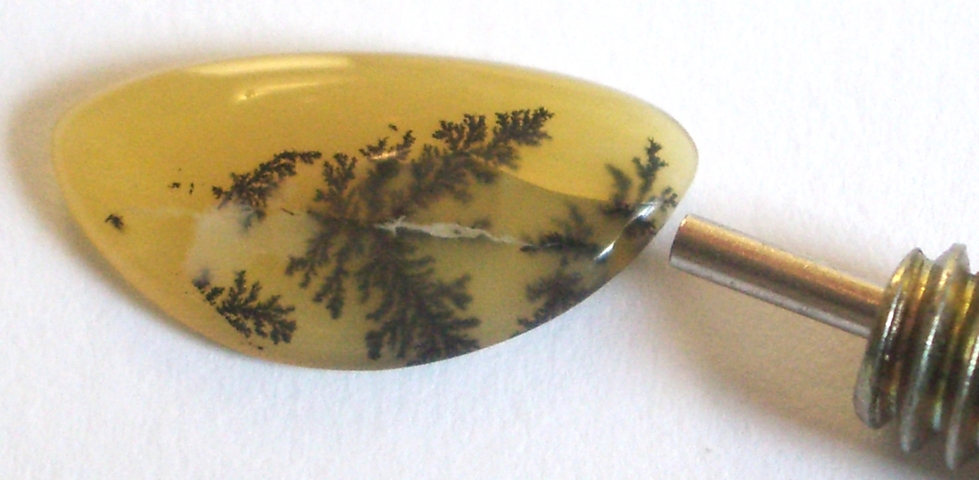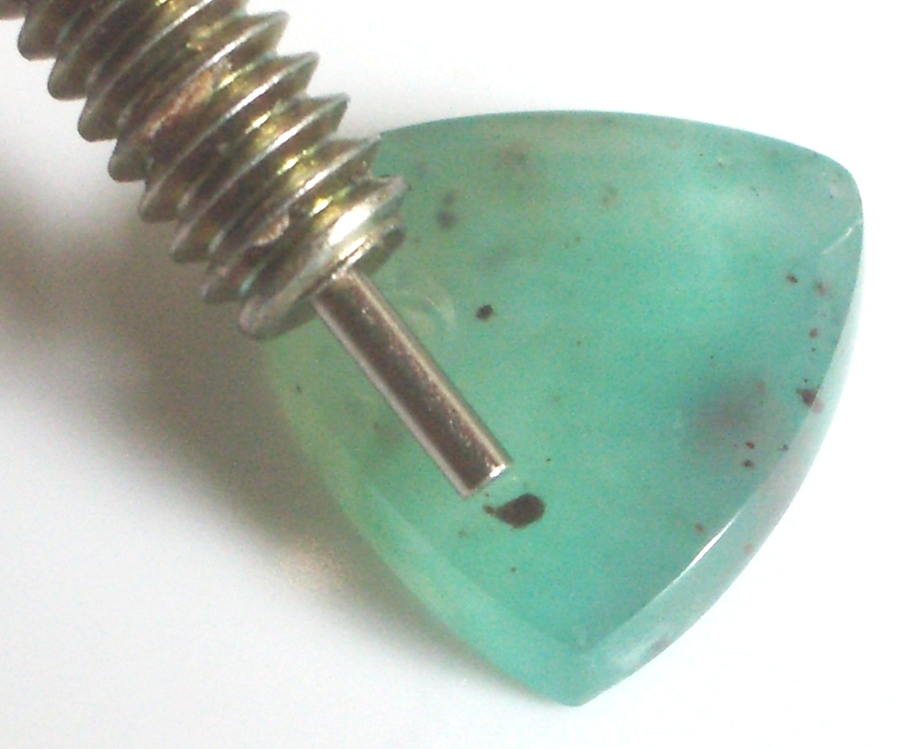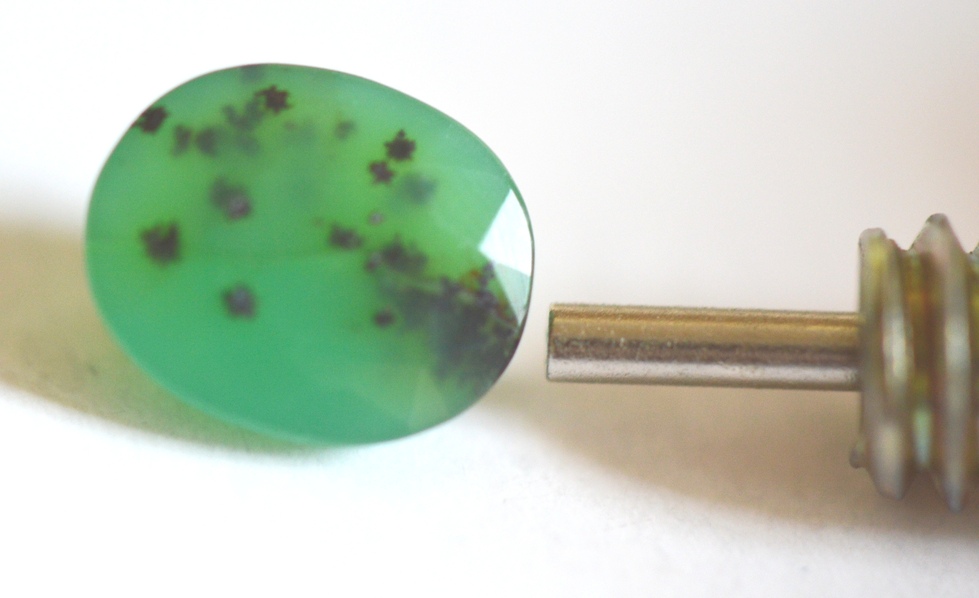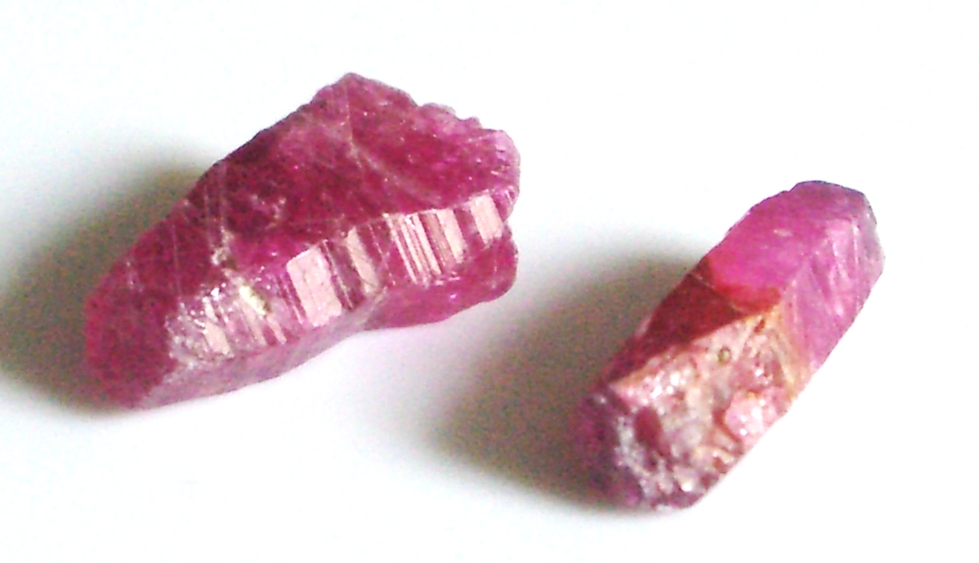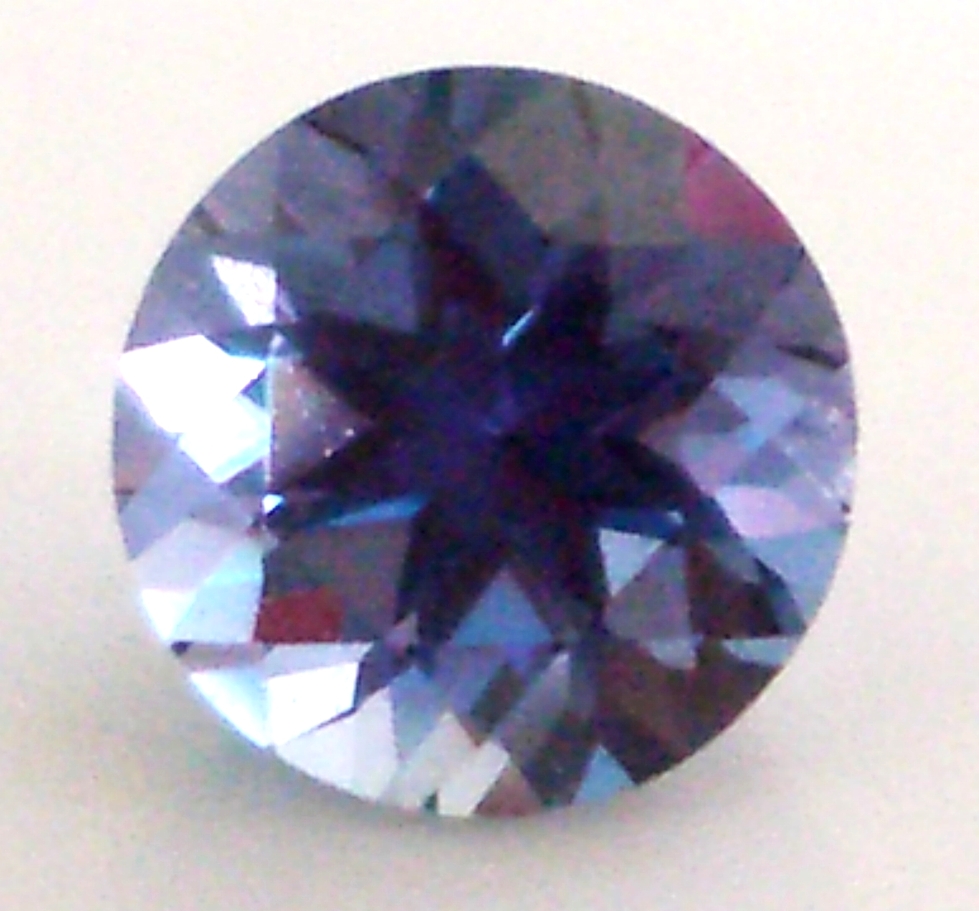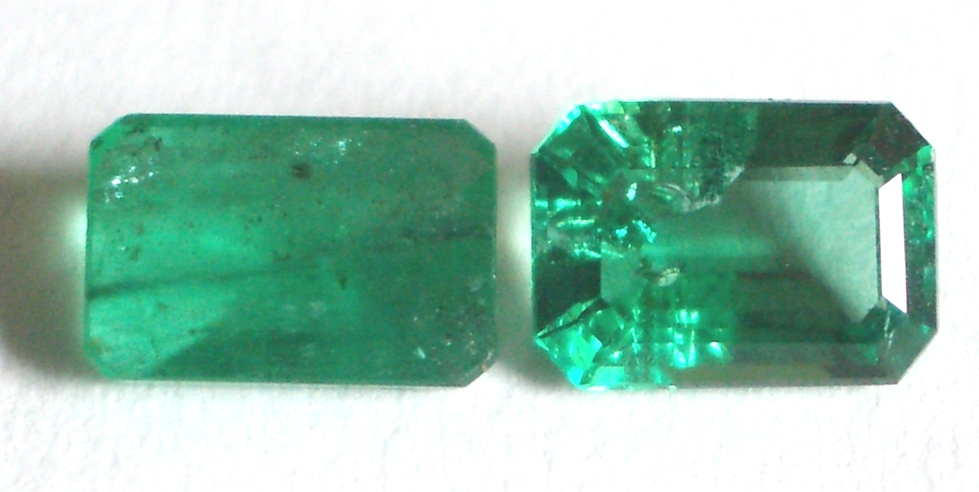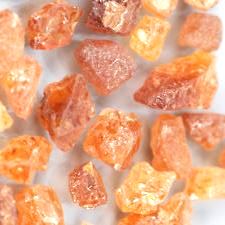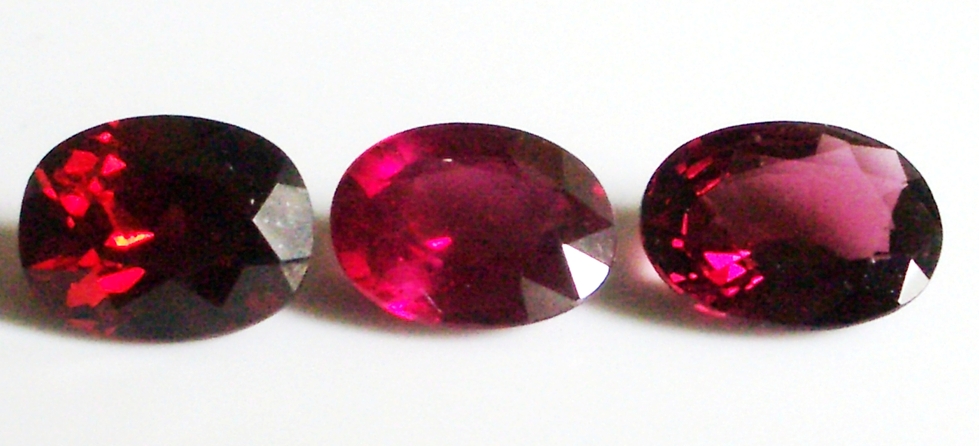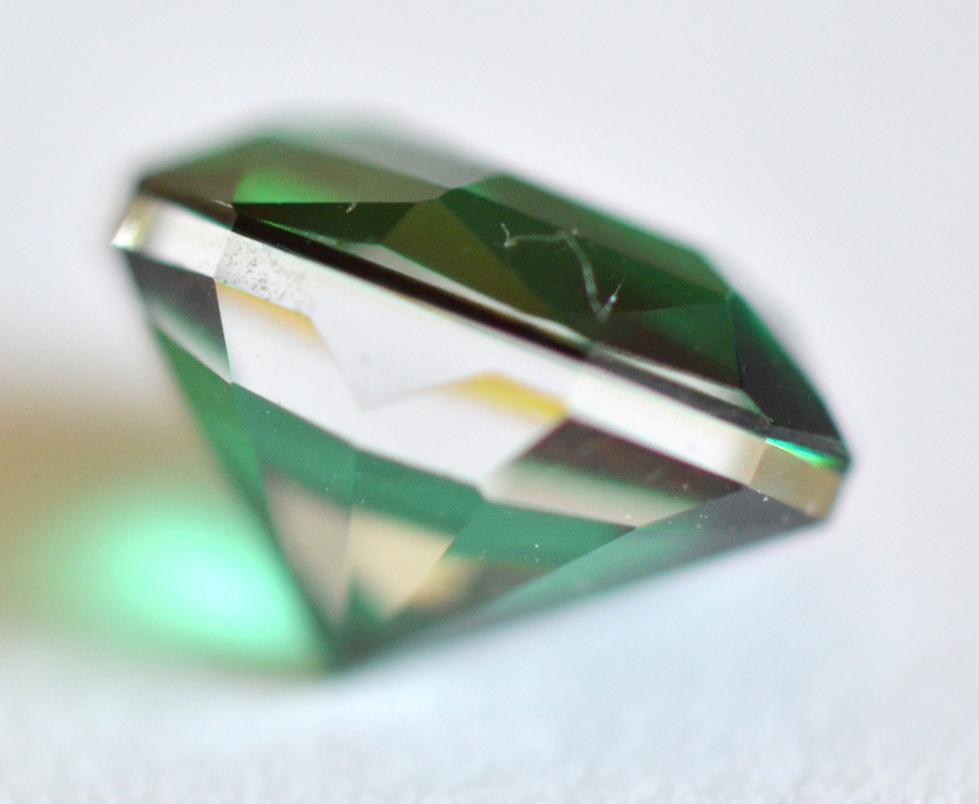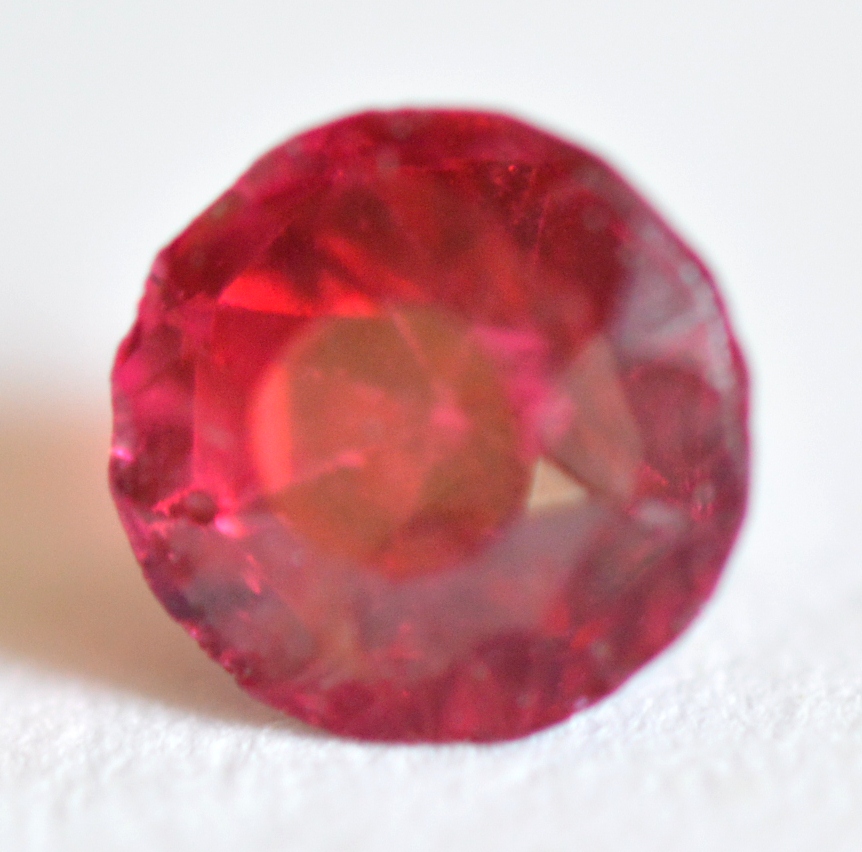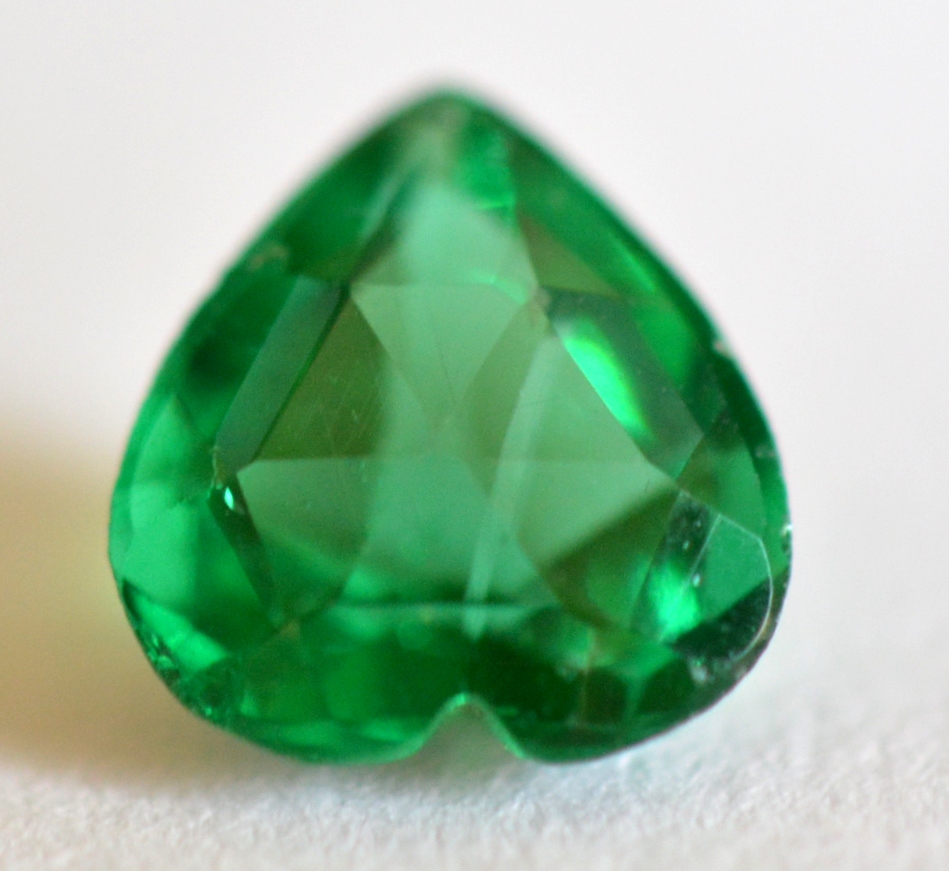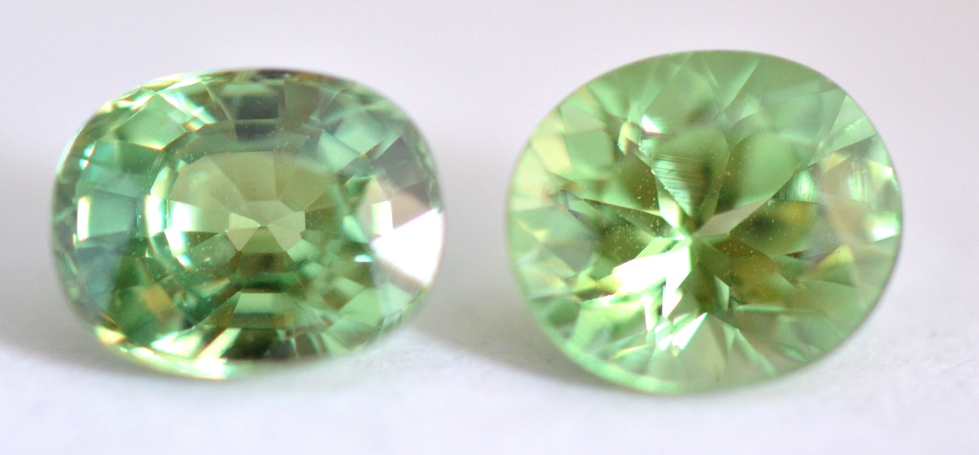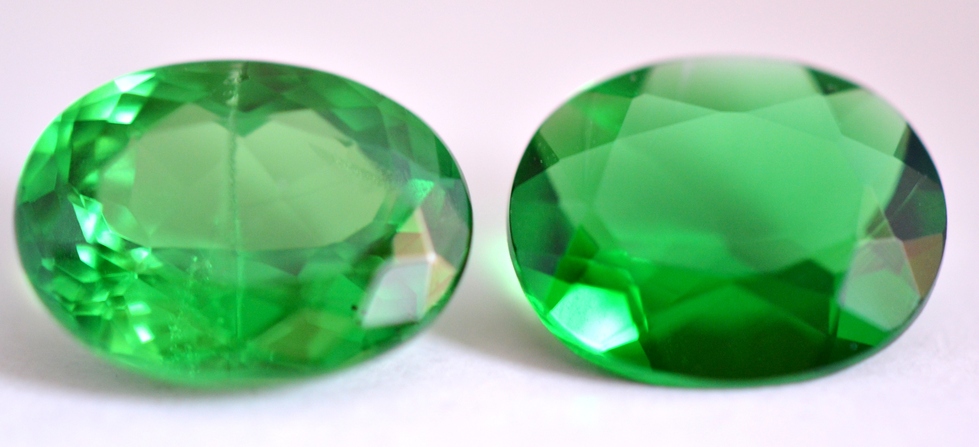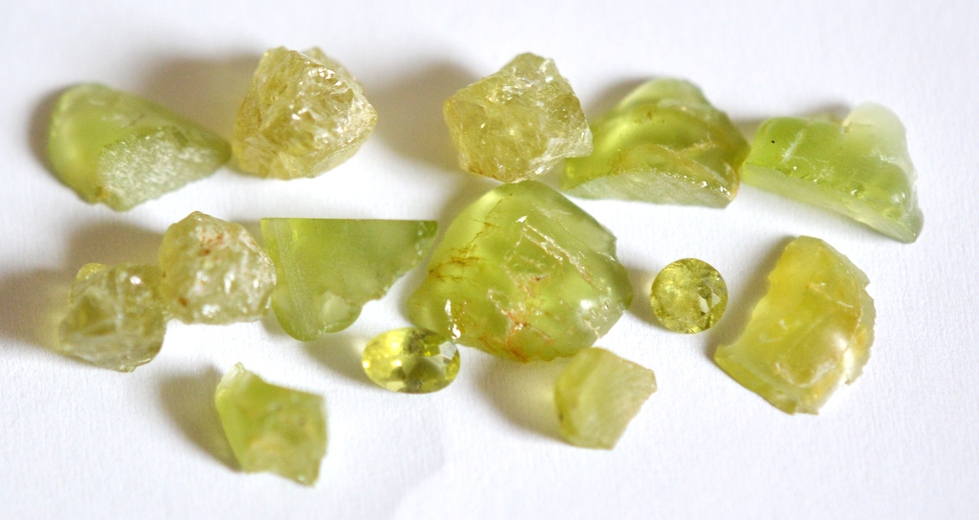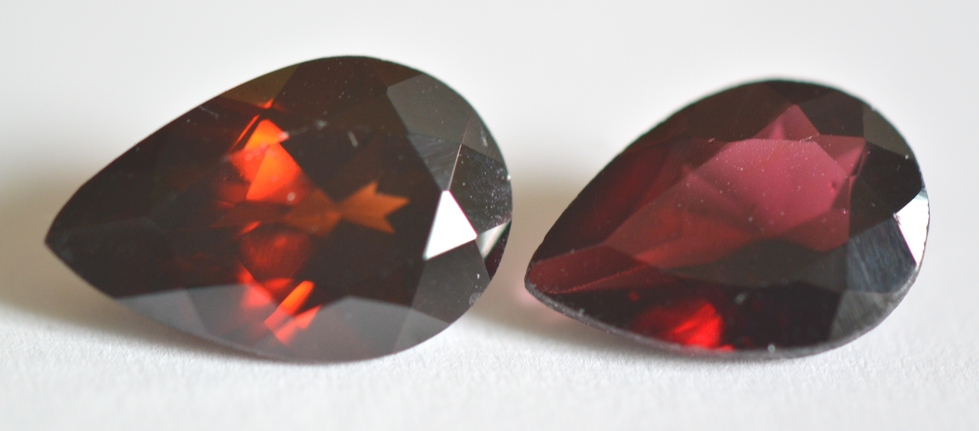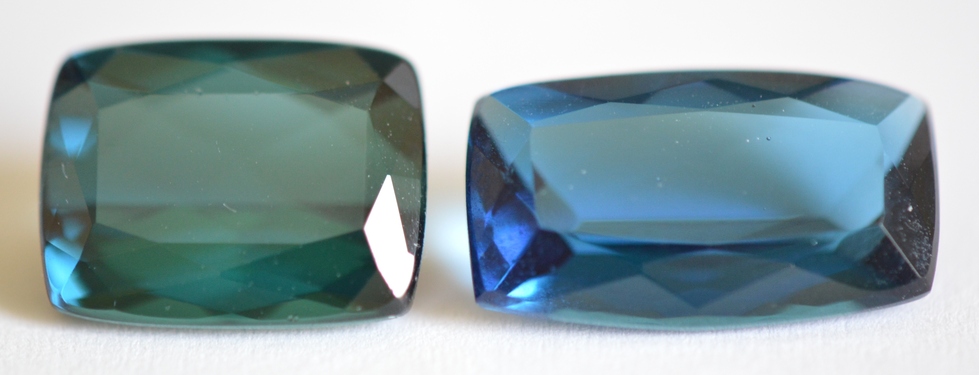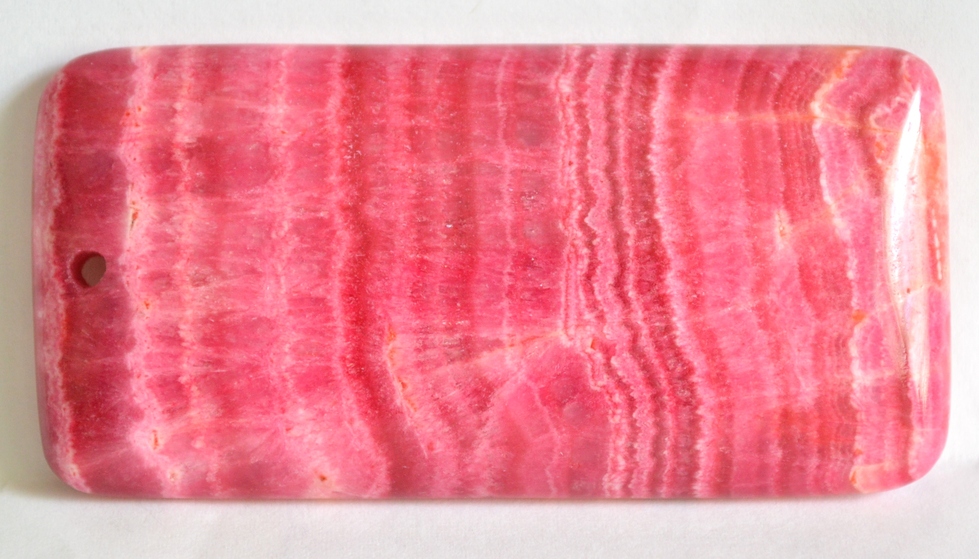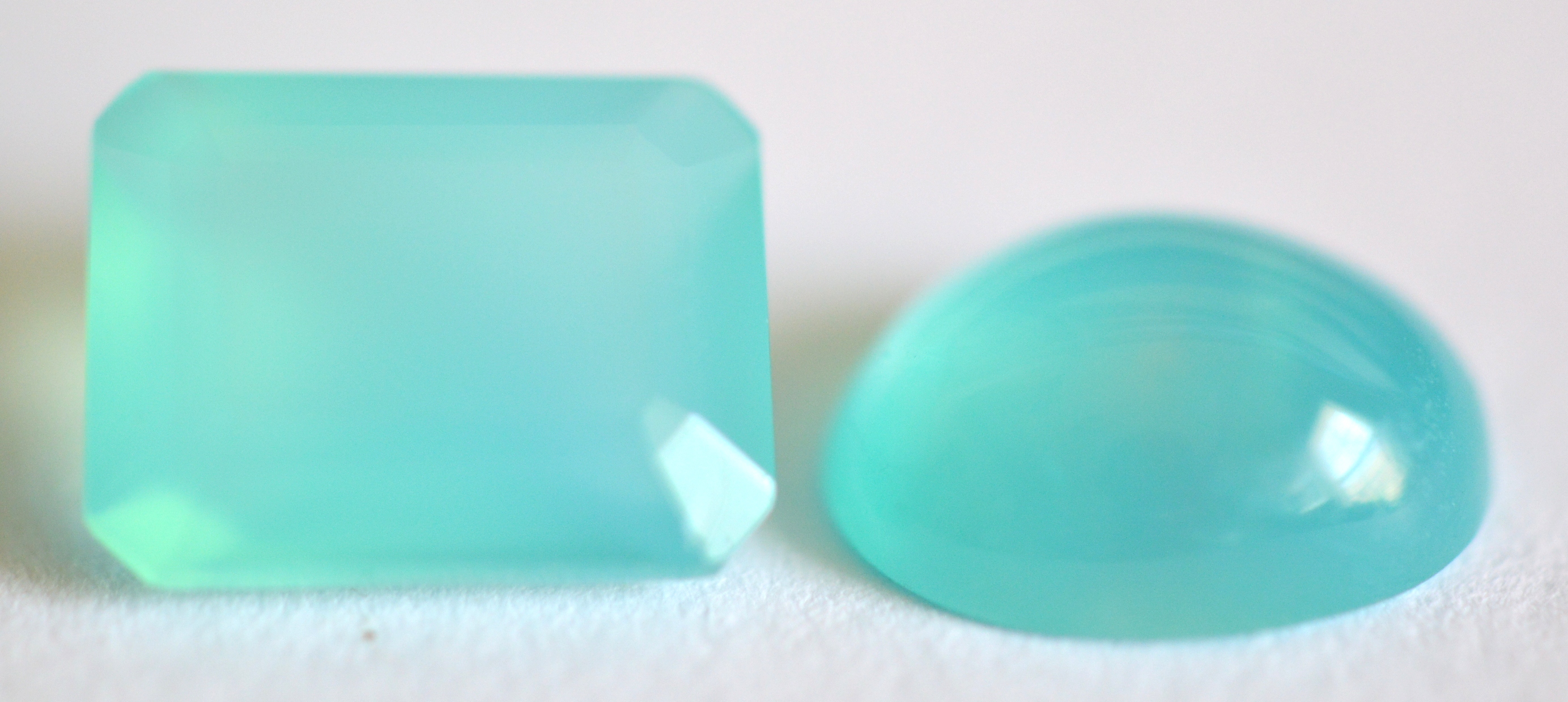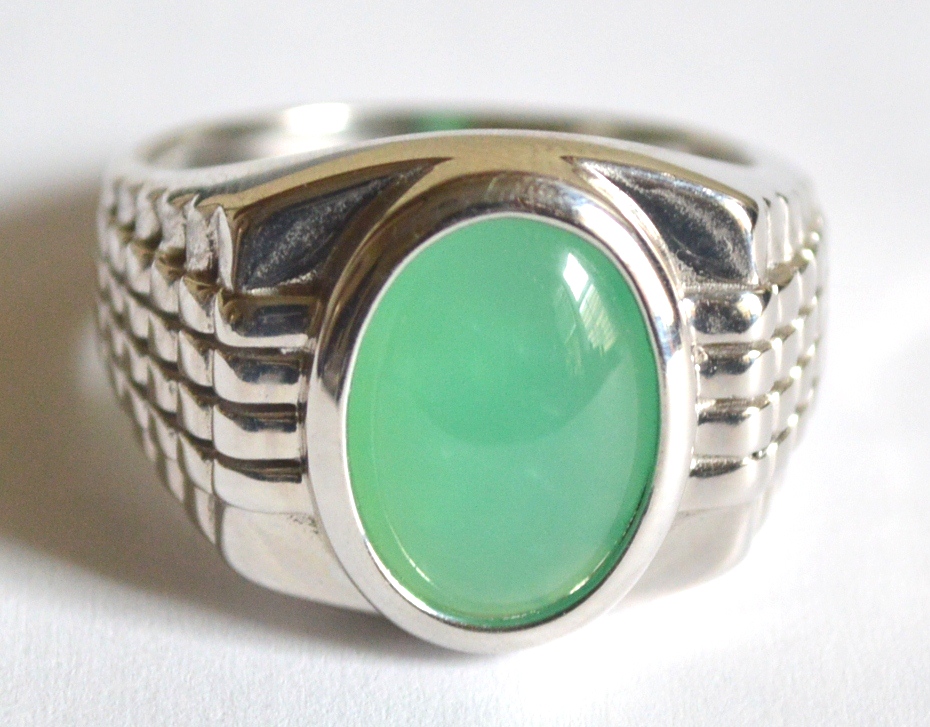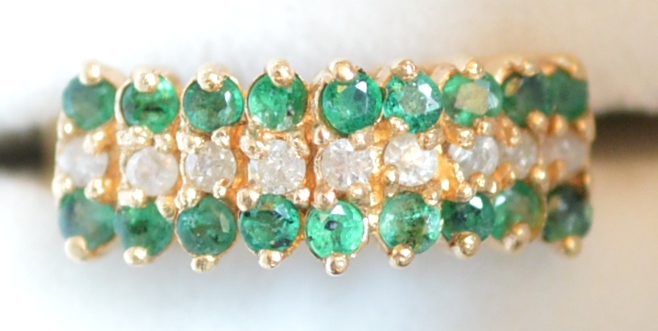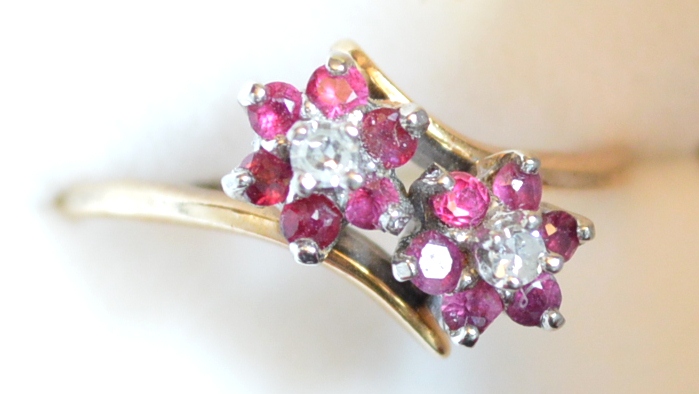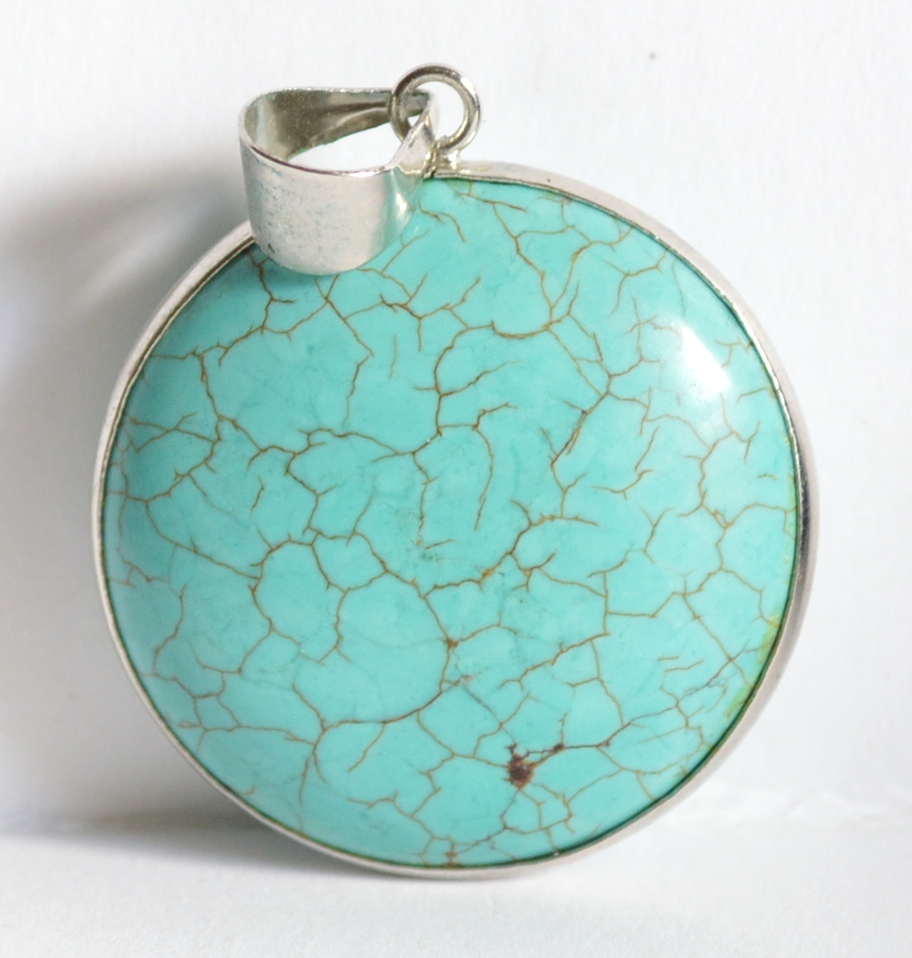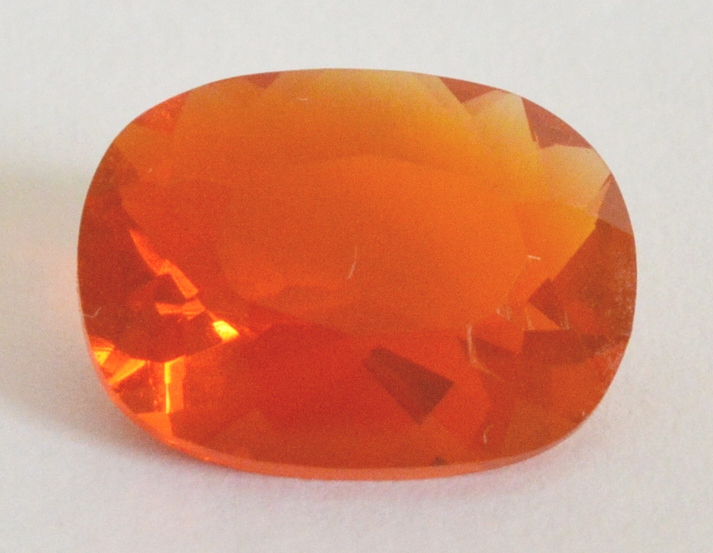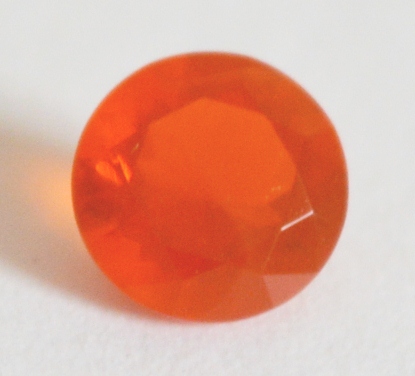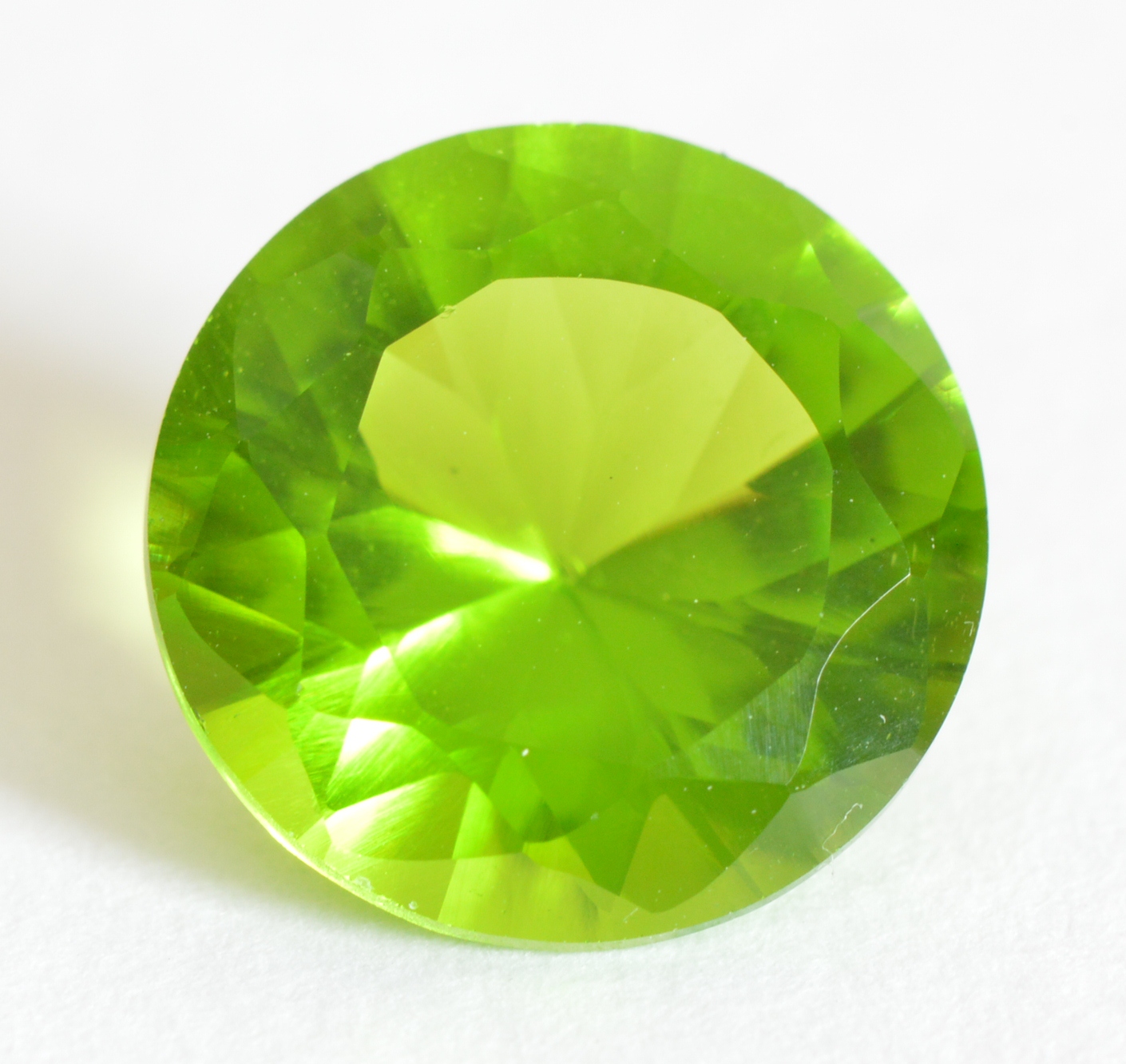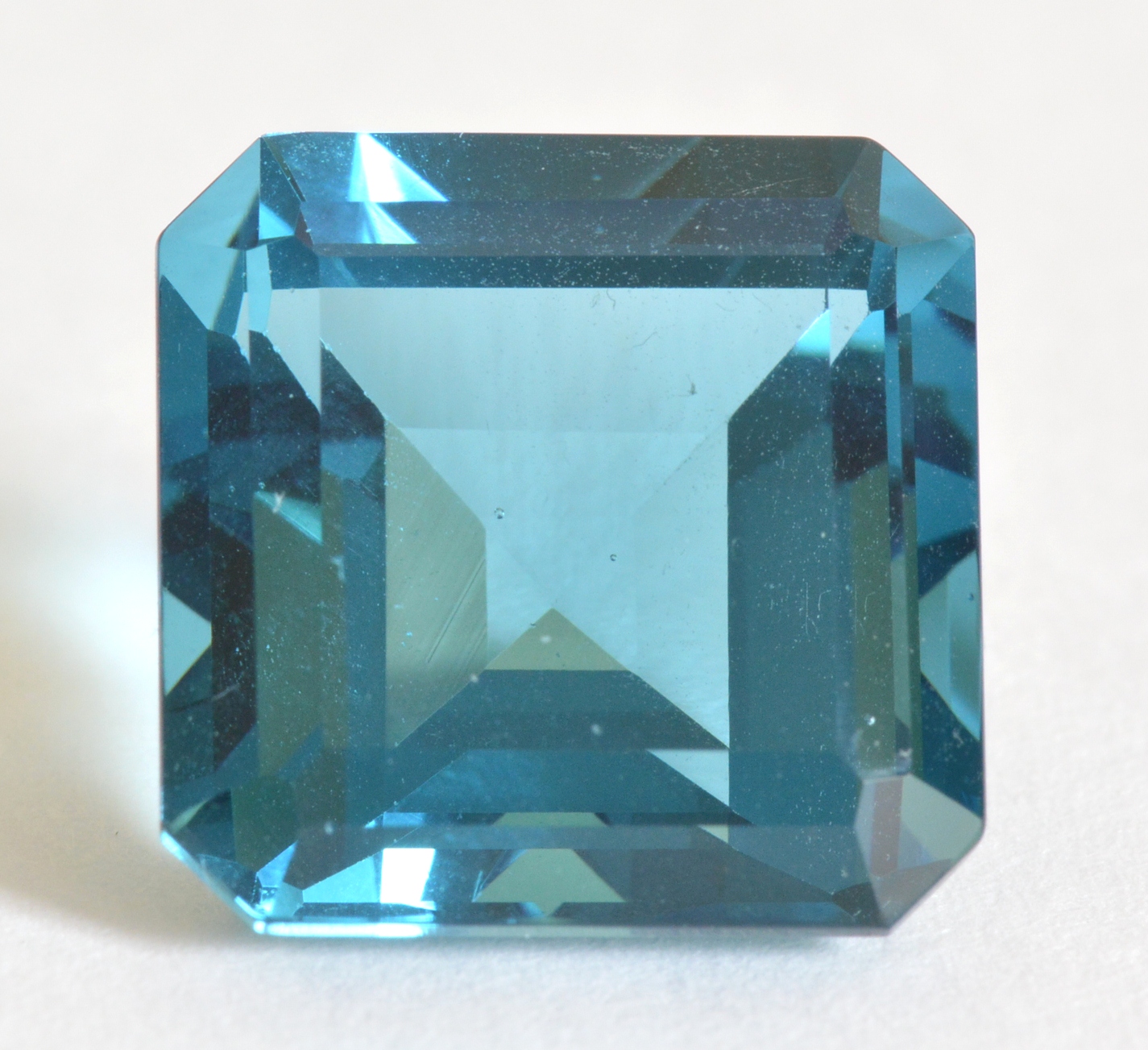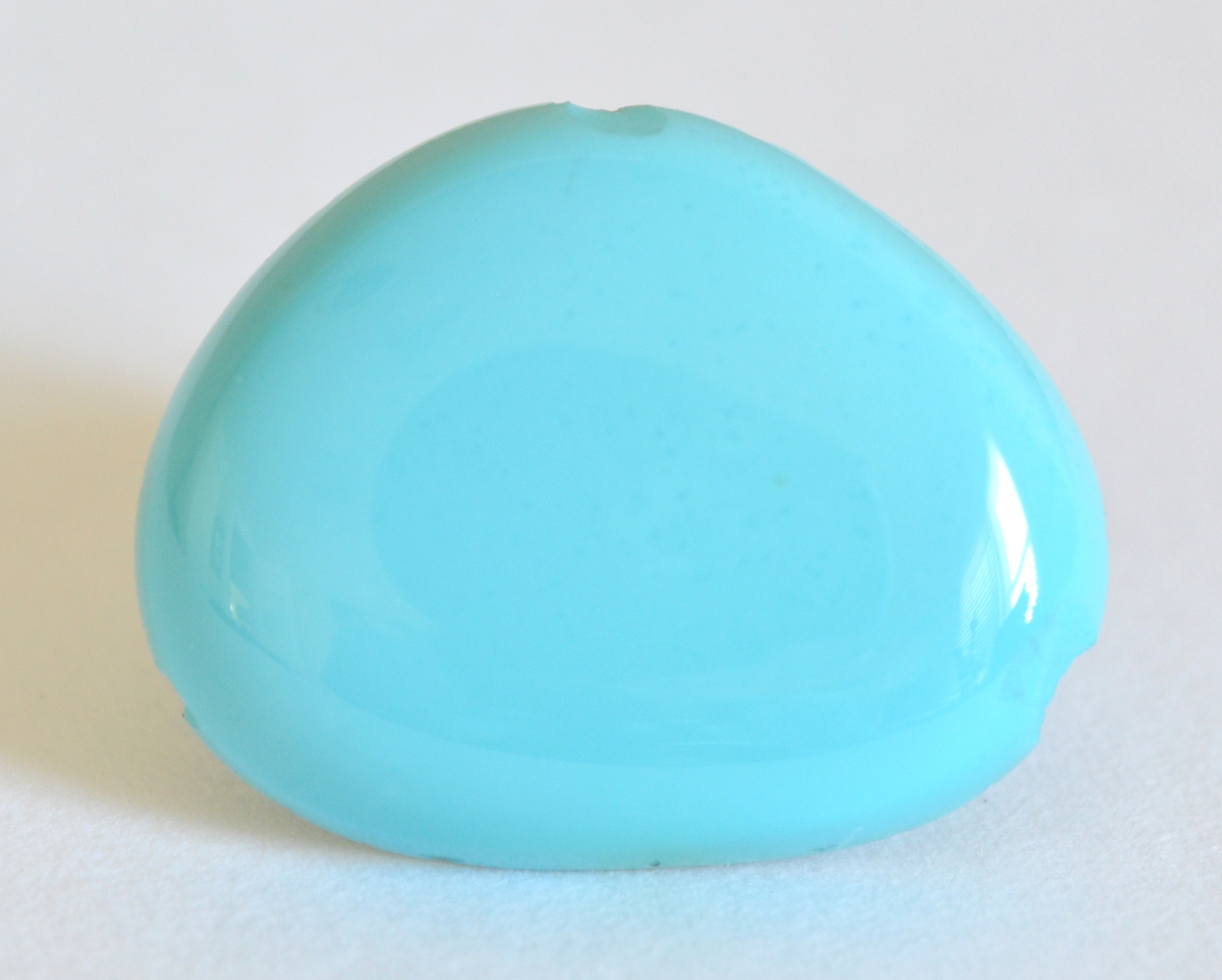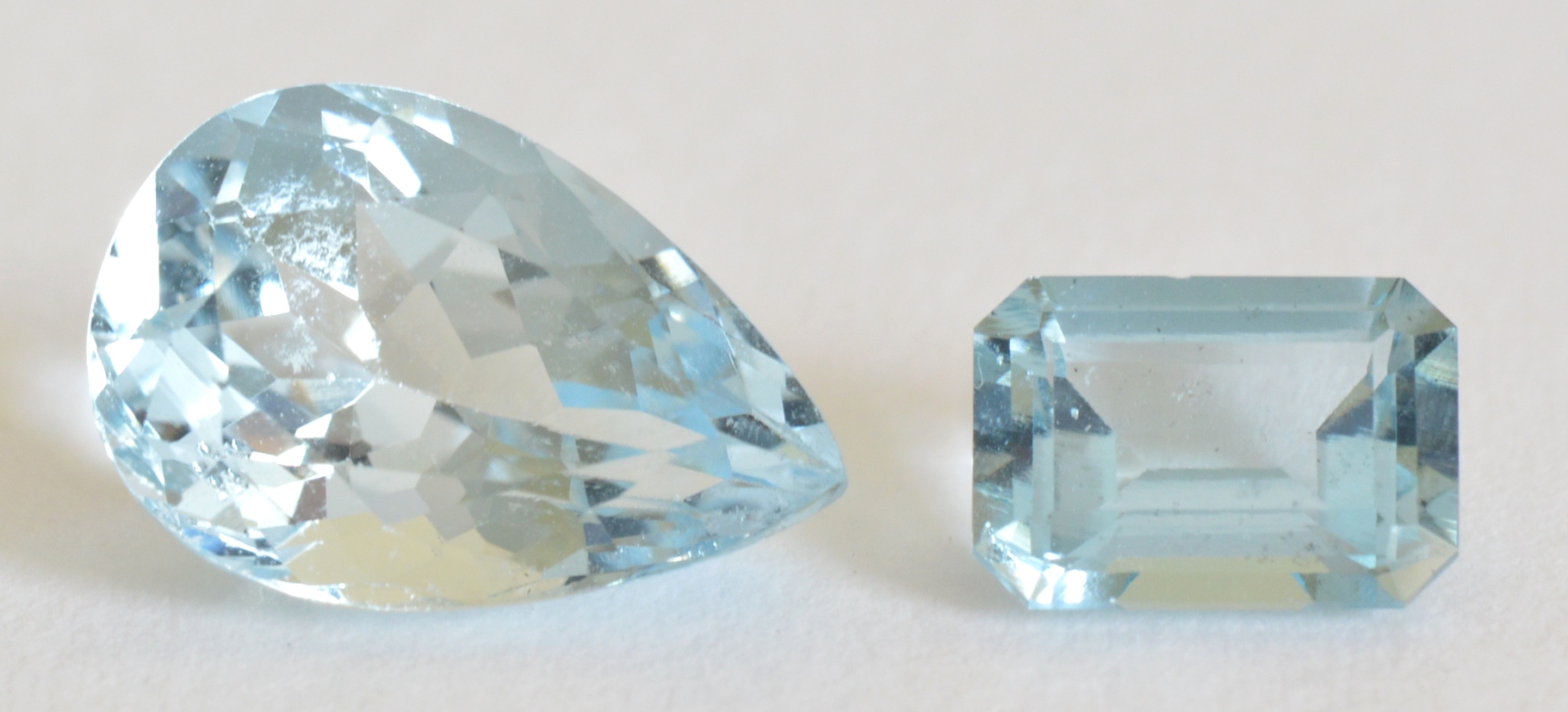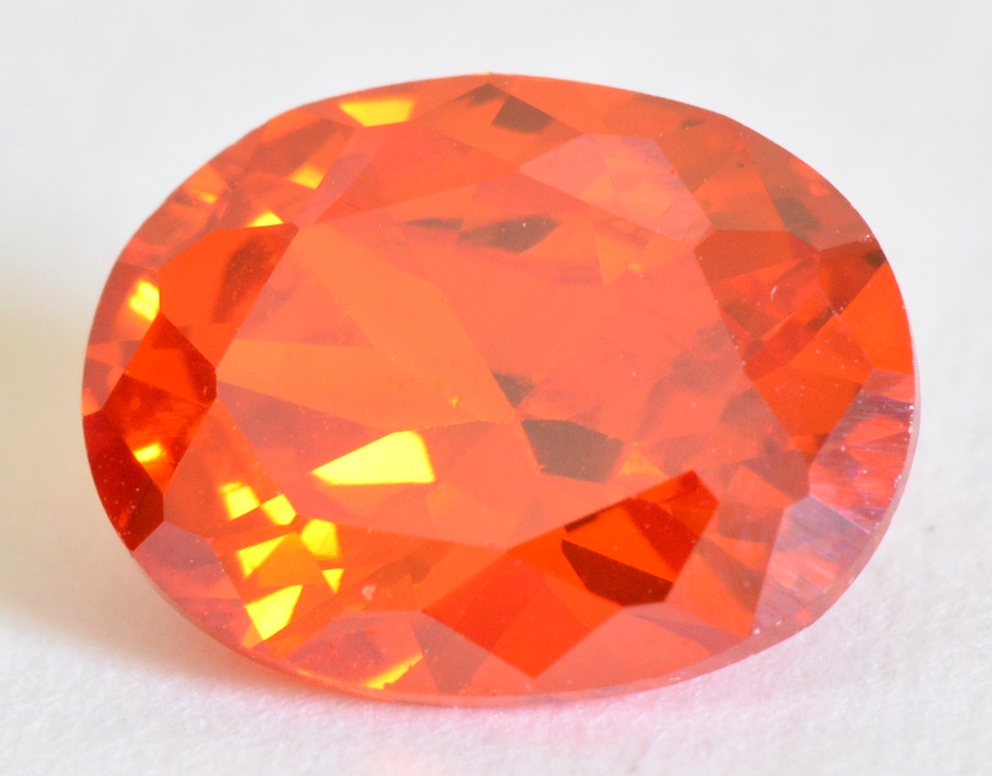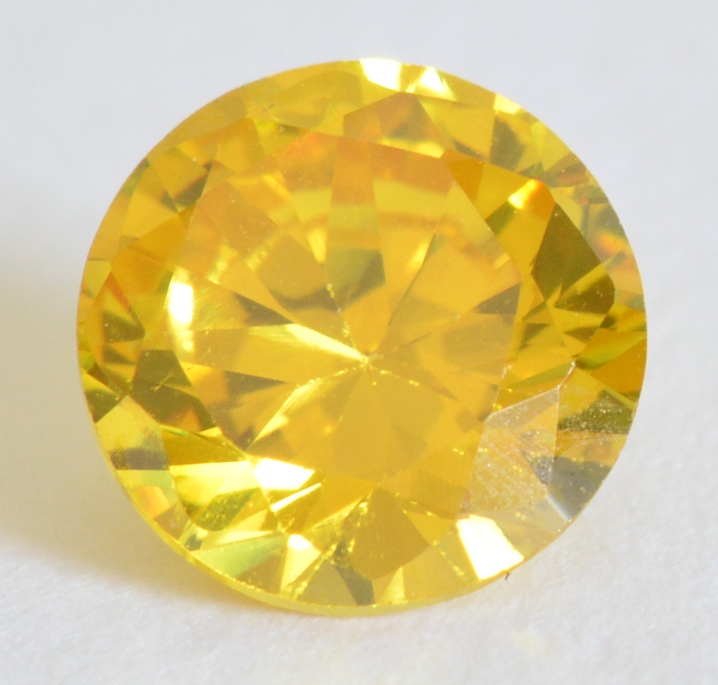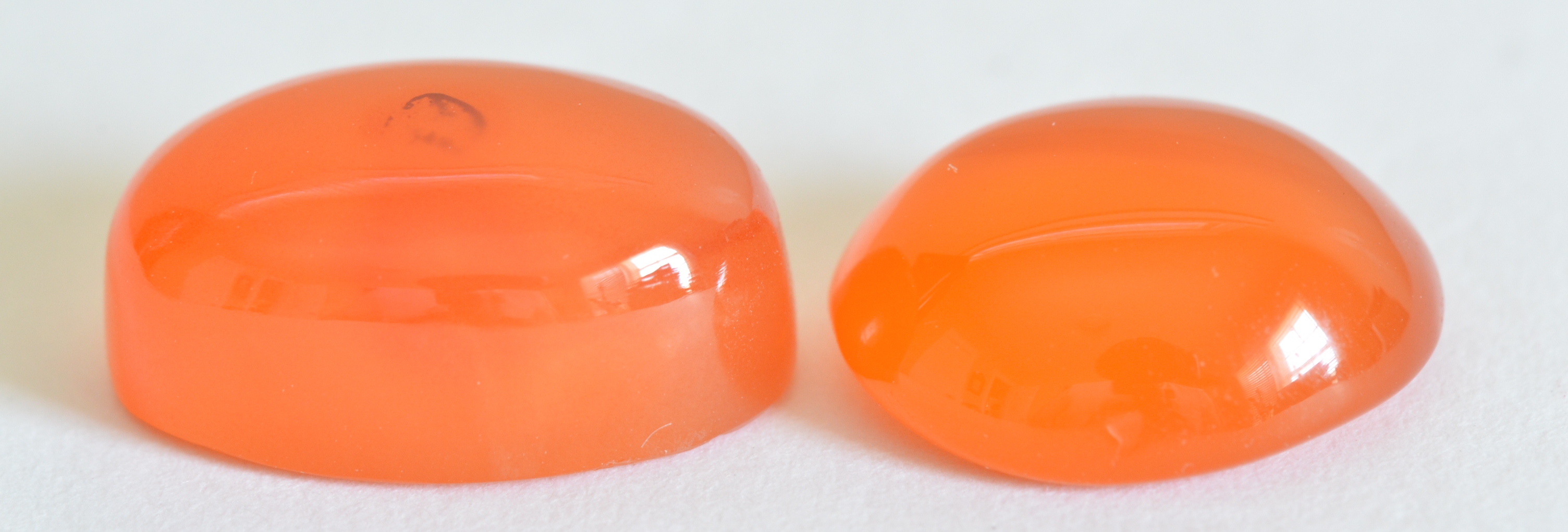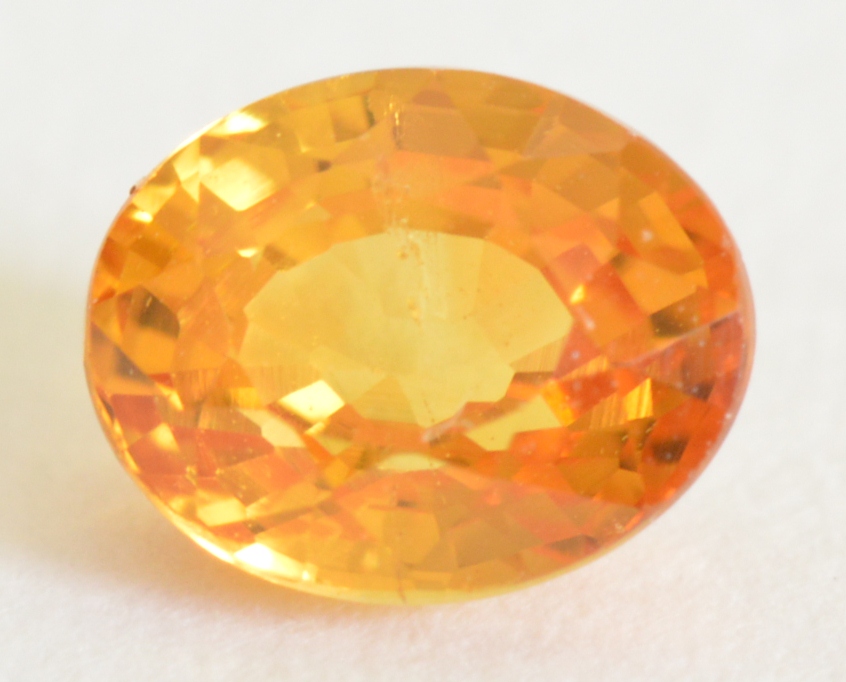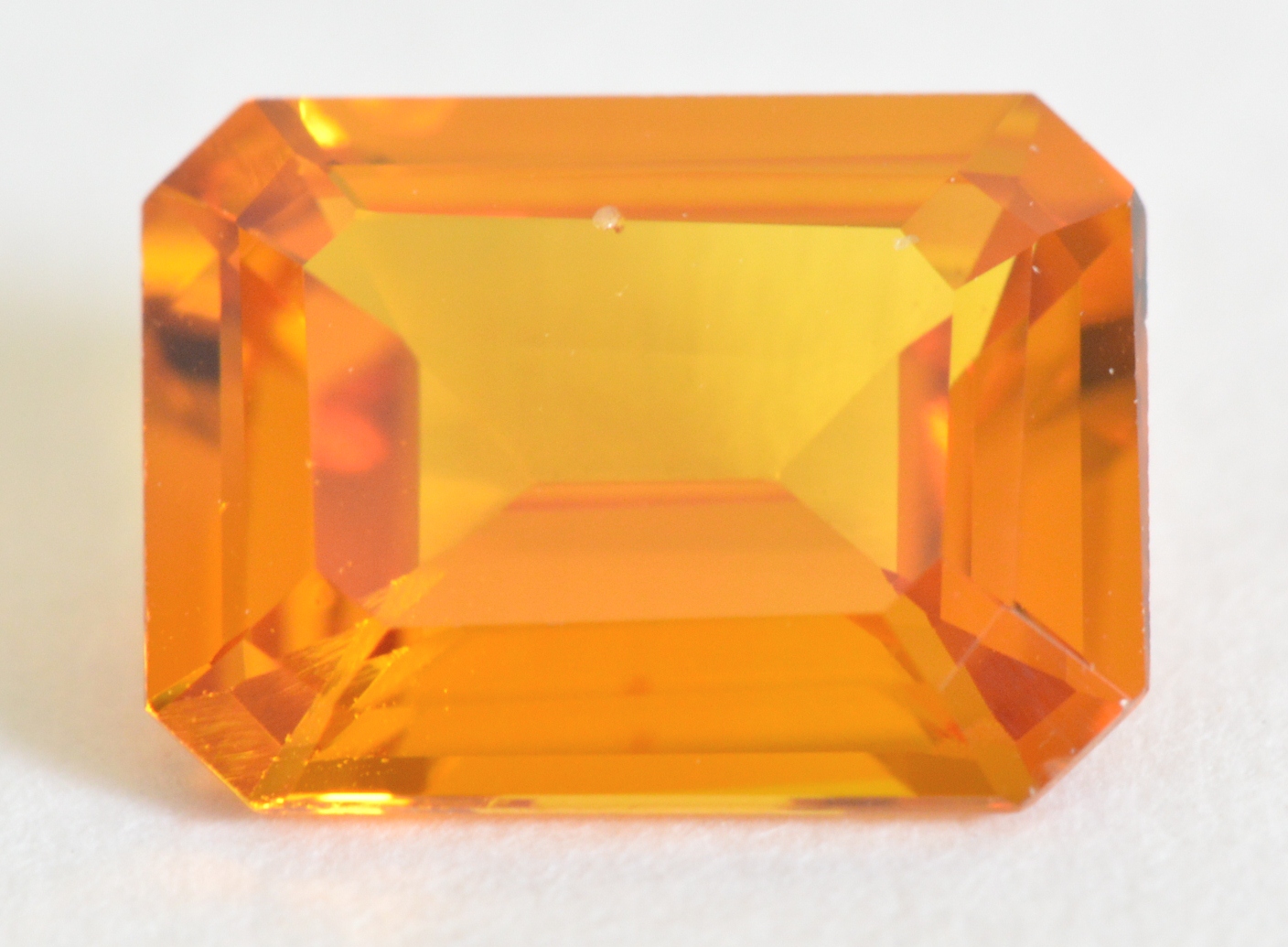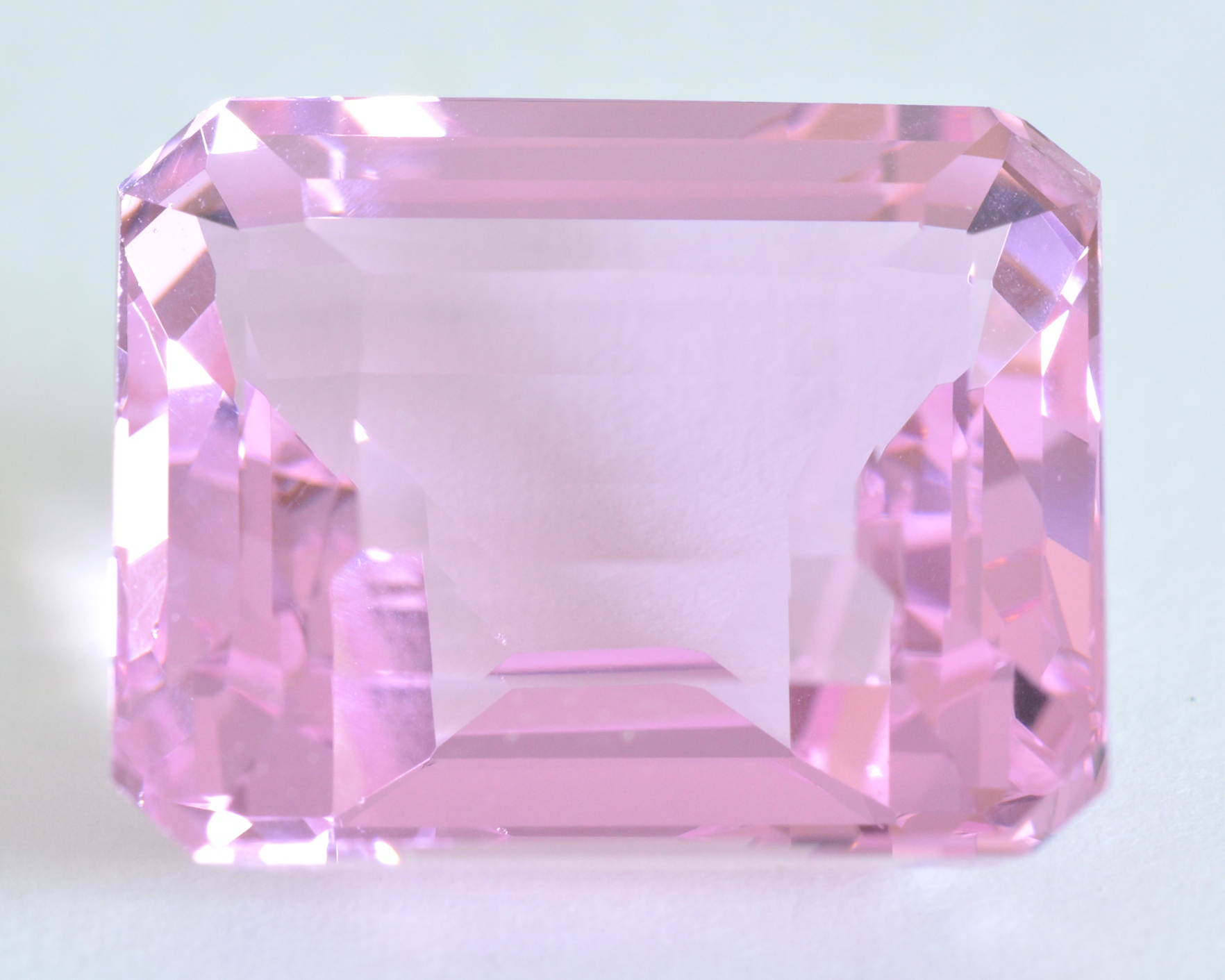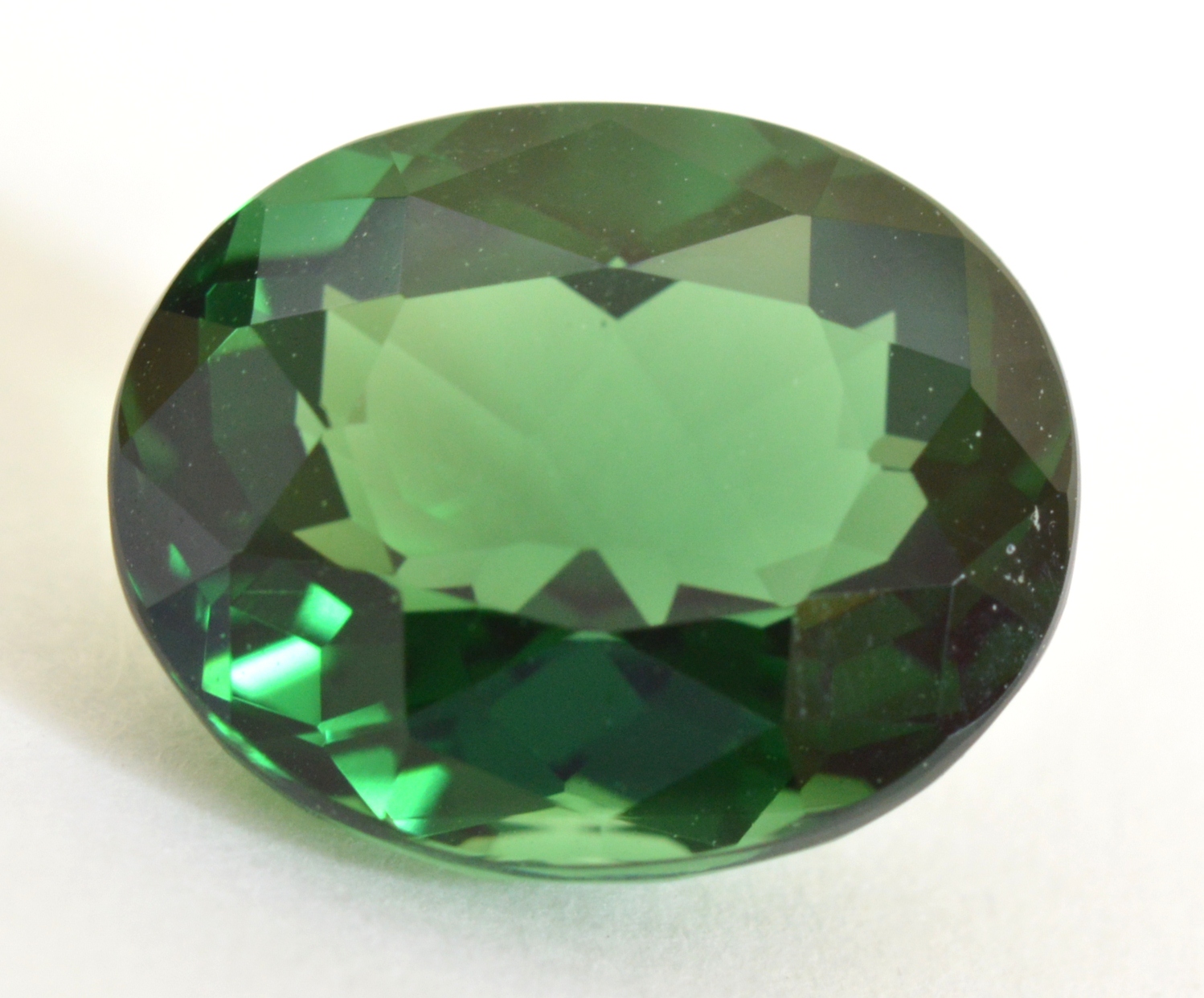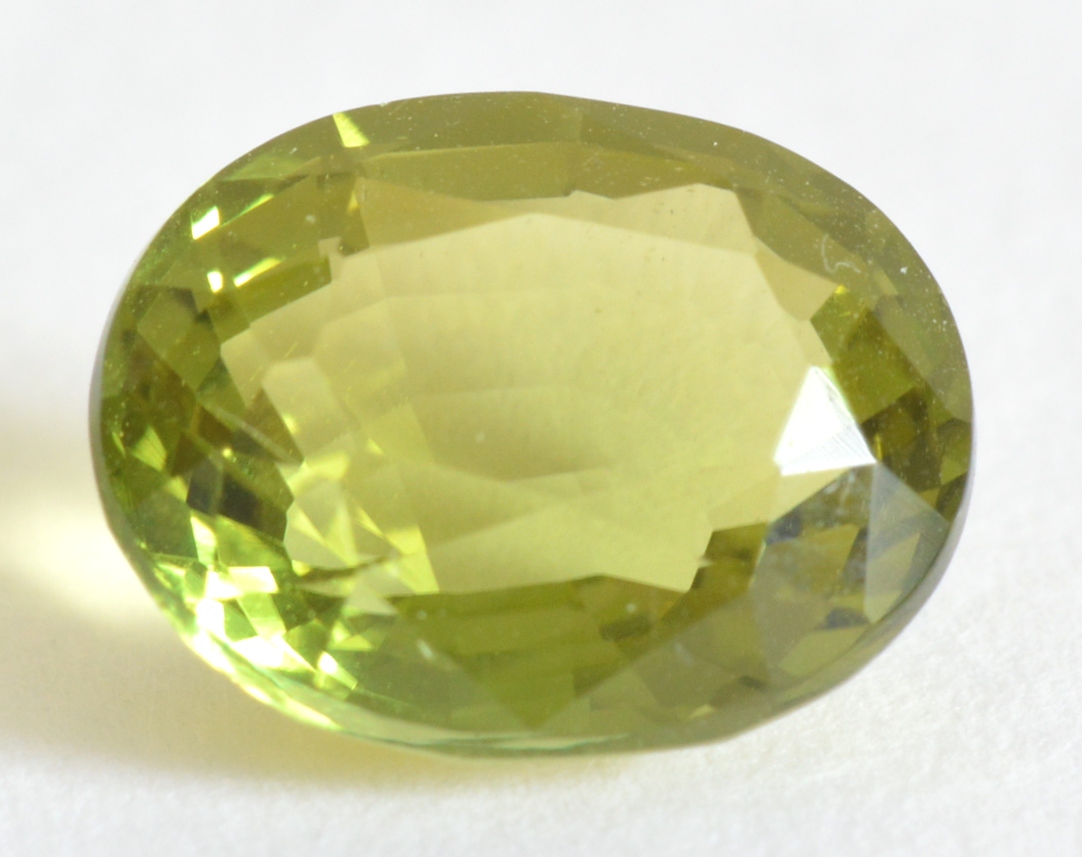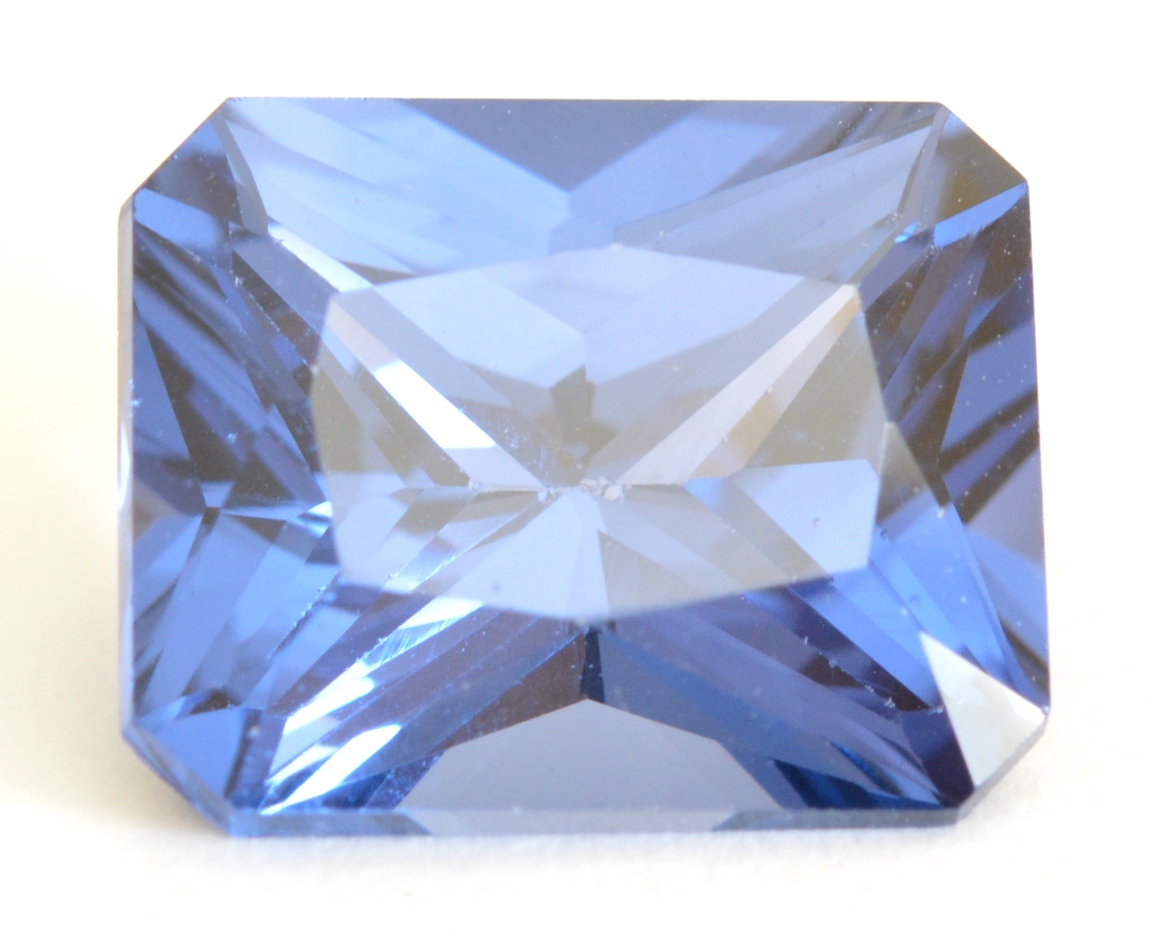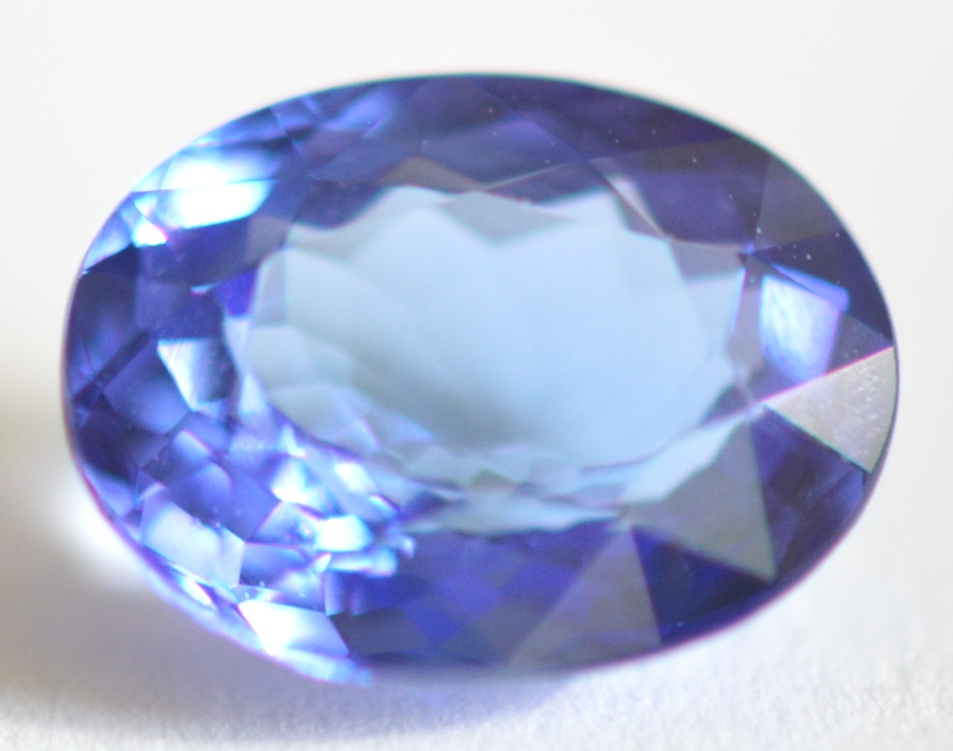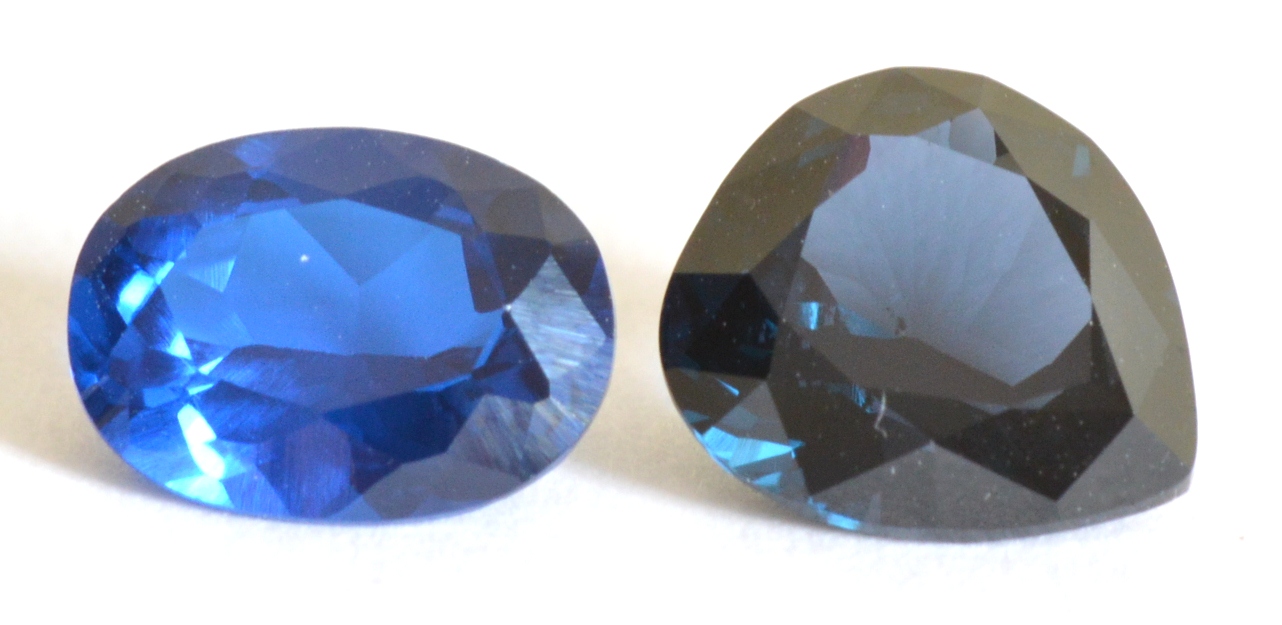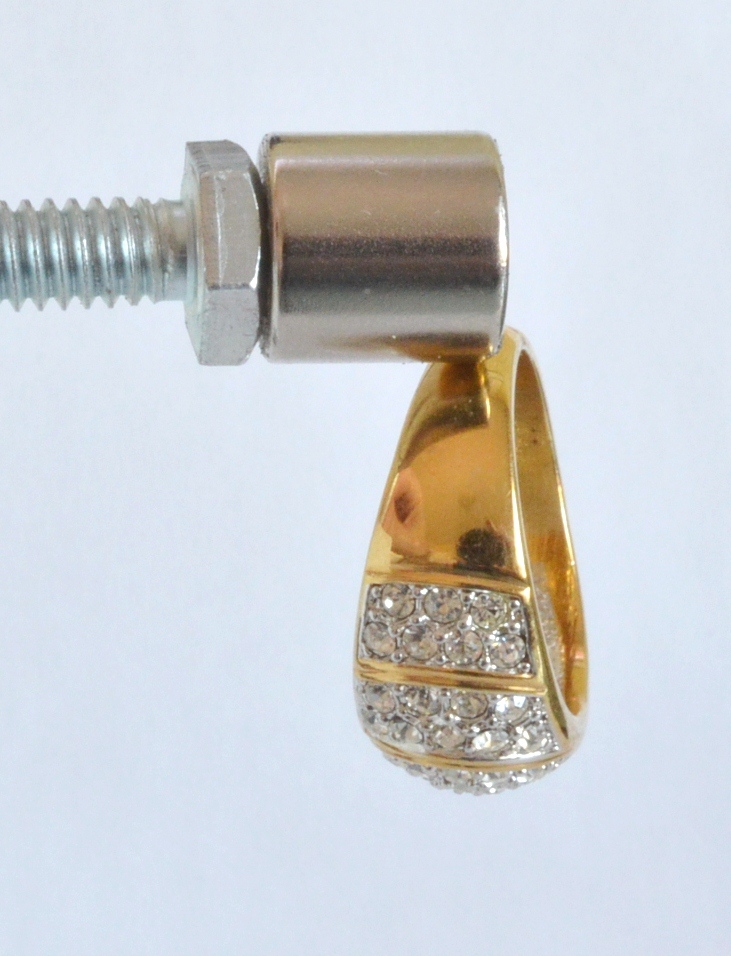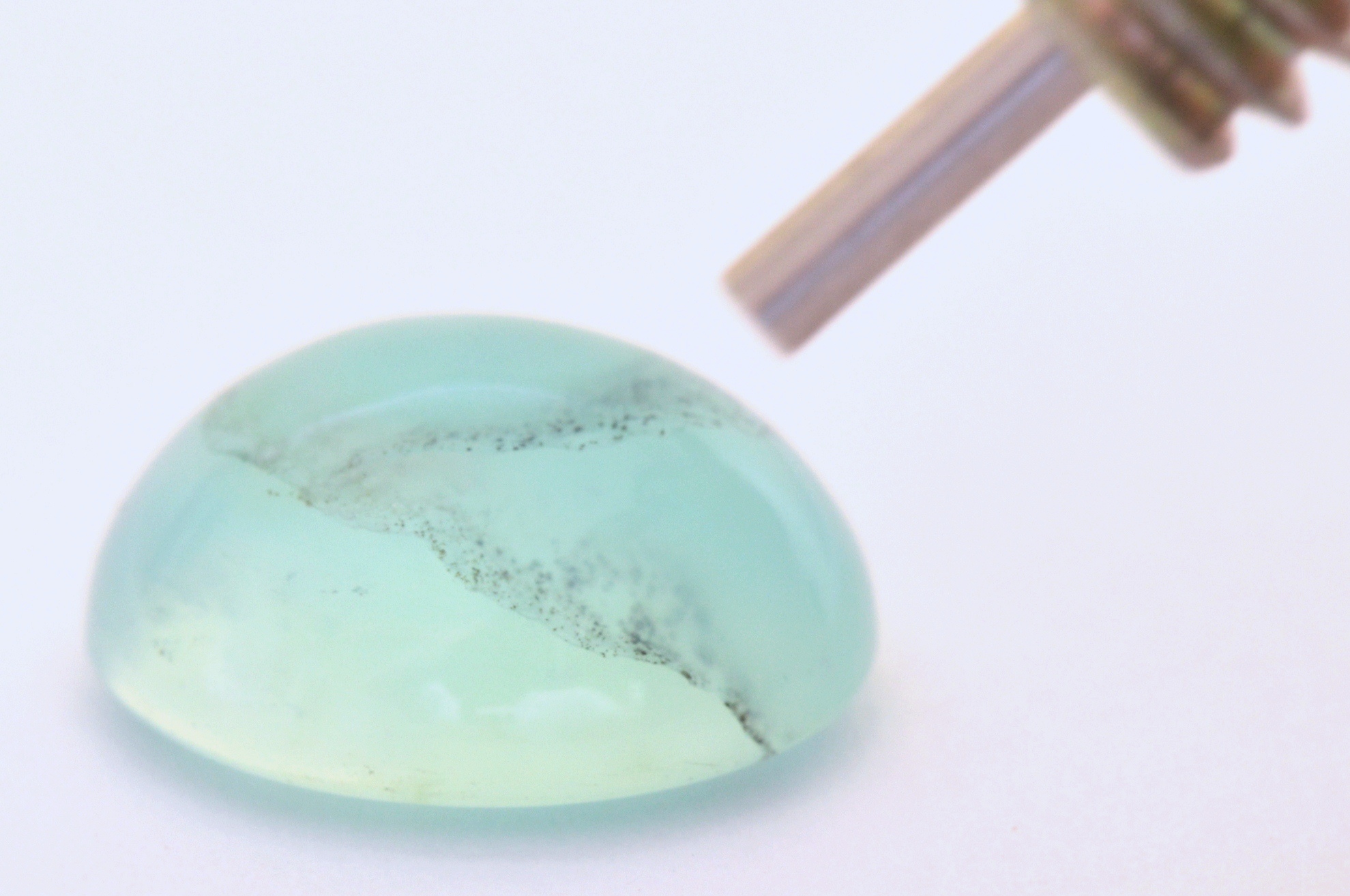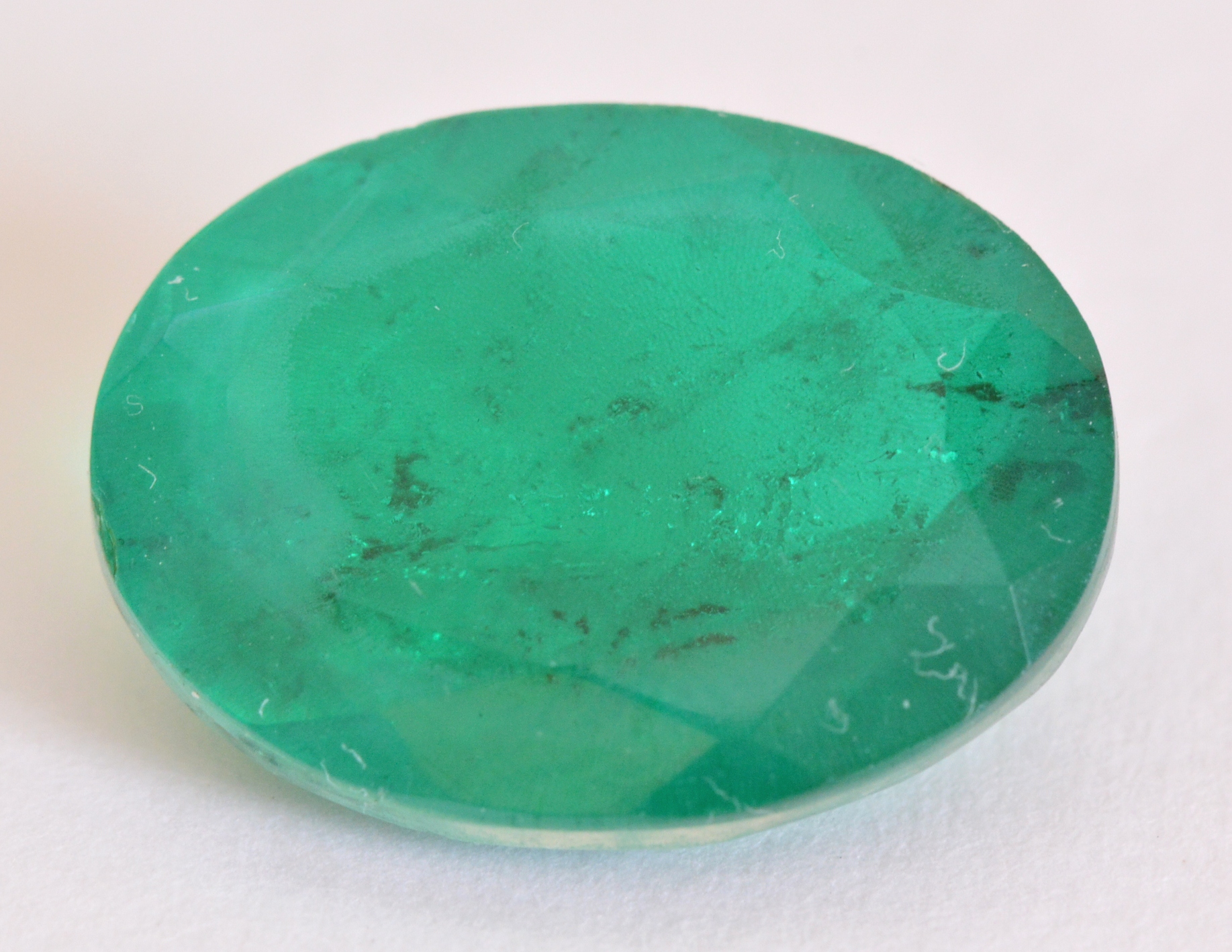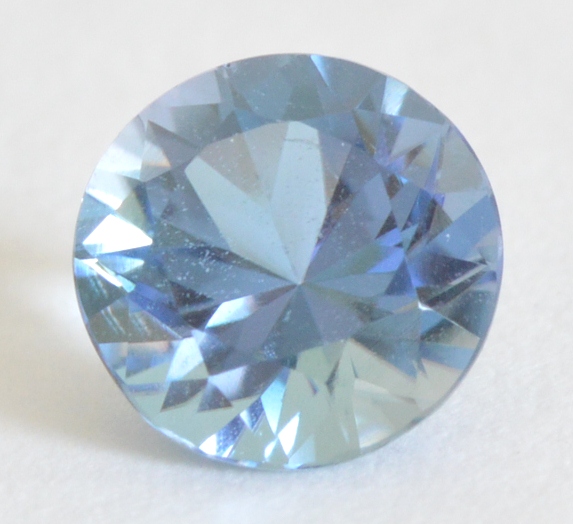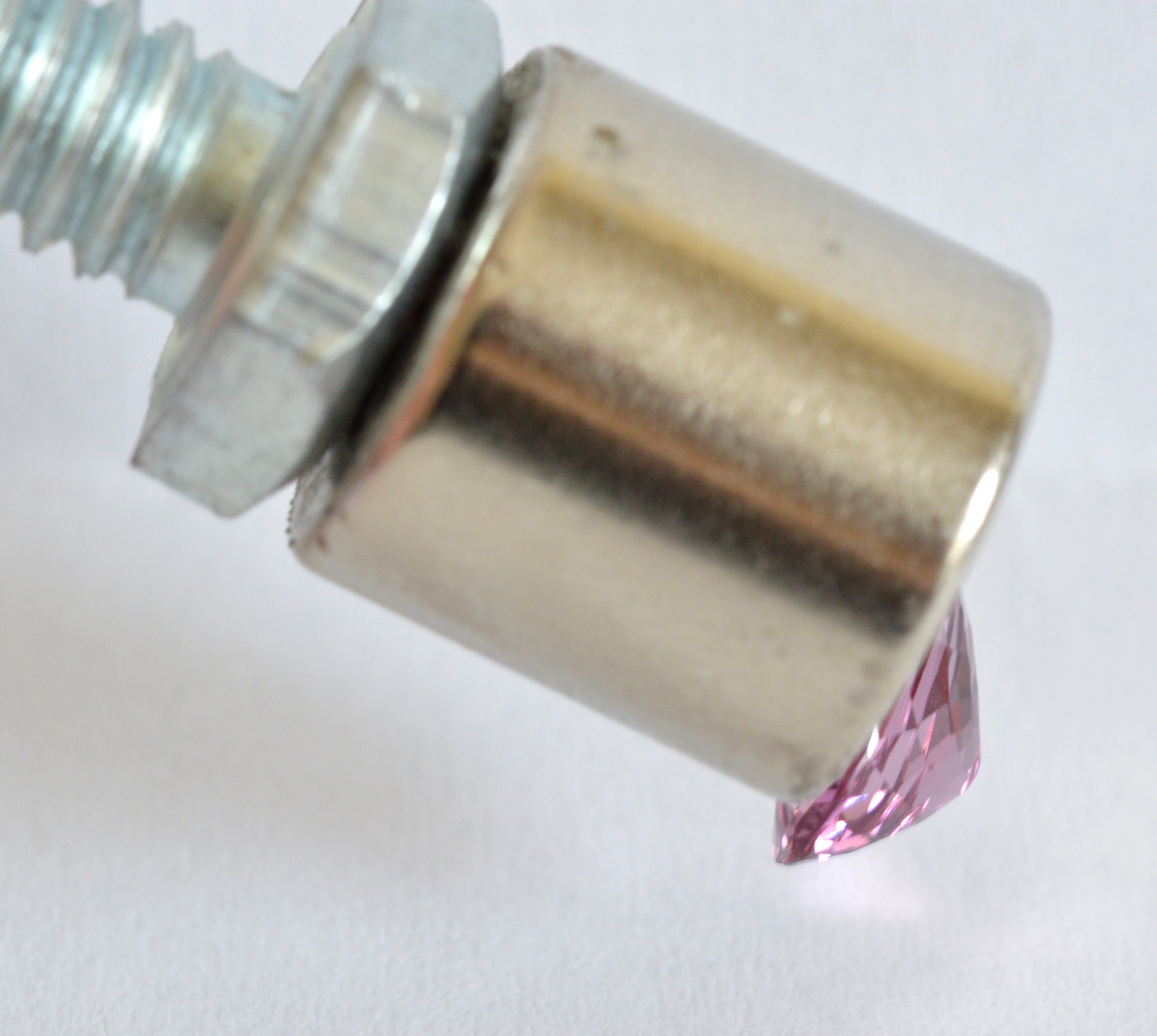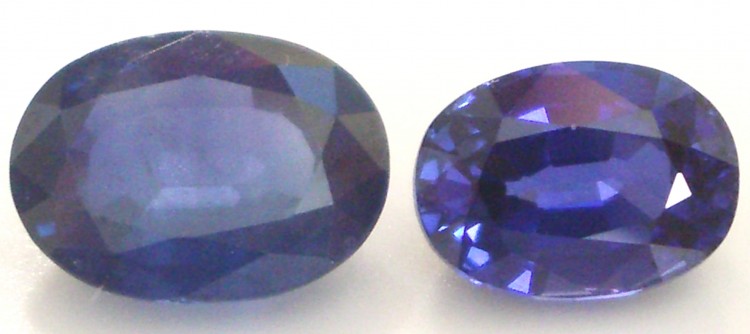Red Garnet Roughs Show Direct Responses
Almandine Garnet (lft), Ruby (ctr), and Red Spinel (rt)
Ruby Roughs Show No Direct Response
Sphene (Weak) & Sphalerite (Inert)
Natural Light Gray-Blue Spinel (Moderate) & Synthetic Light Blue Spinel (Inert)
The Center Stone Responds Strongly
Video: Scanning a Parcel of Rubies
© Kirk Feral 2009-present, All Rights Reserved. These materials may be duplicated and shared for educational purposes only. No part of this website may be duplicated or distributed for profit, for commercial purposes, or for posting to another website, without the expressed written consent of the copyright holder.
3) Gems with a High Refractive Index: Some gems can't be separated by refractive index because readings are OTL (over the limit of the refractometer fluid, R.I. >1.81). However, we can sometimes rely on differences in magnetic response to separate one type of OTL gem from another. For example, natural red Zircon may look very much like red Spessartine Garnet, and Demantoid Garnet may look like natural green Zircon. None of these gems can be measured for their refractive index using a standard refractometer. But a pick-up response quickly separates the Garnets from the look-alikes. A pick-up response also separates Demantoid from synthetic green YAG (Yttrium Aluminum Garnet) and green CZ (Cubic Zirconia). An inert response can separate natural Zircon of various colors from some high-refraction imitations like CZ and YAG that show magnetic attraction. Natural Zircon is almost always inert (diamagnetic).
2) Roughs and Tumbled Stones: Most uncut stones are not suitable for refractometer readings or microscopic examination, but roughs and smooth tumbled stones can always be tested for magnetic response. Ruby and Garnet roughs are easily separated. Red Ruby roughs are too weakly magnetic to show any direct response, while most red Garnet roughs pick up when they are small and lightweight, or drag when they have greater bulk (over 4 or 5 carats). Another good separation tool is a UV flashlight. Only the Rubies will fluoresce under UV light, although not all Rubies fluoresce.
Imitation Turquoise: Natural blue and green Turquoise gems are weakly to strongly magnetic due to copper salts (copper phosphate), but imitations made from dyed natural materials such as dyed Howlite, dyed Magnesite and imitation Odontolite (dyed fossil bone or ivory) are easily detected by their inert responses. Imitation Turquoise gems fashioned from man-made materials such as ceramic, glass or plastic are also inert and can be quickly spotted.
Natural Sapphire (Weak) & Synthetic Sapphire (Inert)
7) Treated Gems: In most cases, magnetic testing cannot distinguish between treated and untreated natural gems. We have already mentioned untreated and treated Turquoise. Another example is natural red Labradorite Sunstone, which responds to a magnet the same way as diffused red Andesine. Both are Feldspar gems that are weakly magnetic due to traces of iron. Gems of any kind treated with heat, irradiation, surface diffusion, coatings, dyes, oils or fissure fillings respond to a magnet in the same manner as their untreated counterparts.
Synthetic Emerald: Magnetic testing also cannot reliably distinguish natural Emerald from synthetic Emerald. Natural Emerald contains iron (Fe3+) impurities in addition to chromium and vanadium. Most synthetic Emerald is doped only with chromium and/or vanadium, but some may also contain iron. High concentrations of chromium/vanadium in synthetic Emerald, along with some possible iron, can generate weak to moderate magnetic responses (and rarely strong responses) that appear similar to the magnetic responses of natural Emeralds containing low concentrations of iron. The magnetic response ranges of natural and synthetic Emerald therefore overlap.
Glass Imitations: Glass has been used to imitate natural gems for thousands of years, and today it is still probably the most common gem imitation. Glass production is faster and cheaper than growing crystalline materials. Glass can be doped to produce any color, and molded or faceted into any shape, but unlike natural gems, glass gems seldom contain magnetically detectable iron or other metals.
The vast majority of Glass gems are magnetically inert (diamagnetic). For example, iron in natural Peridot creates green color. The drag response we see when a magnet is applied directly to Peridot separates the Peridot from green Glass imitations, which are inert (diamagnetic). The Glass imitation shown below (right) is colored by vanadium.
6) Faceted Doublets: Faceted doublets are composite gems made to simulate Ruby, Sapphire, Emerald and other natural stones. Often these are meant to deceive. A faceted gem with a crown made of a thin slice of natural gem material coupled with a colored pavilion made of man-made material can be difficult to detect with the naked eye. The gem derives its desired color from the man-made pavilion while retaining the natural inclusions and refractive index of the natural crown material. The refractive index of a Garnet crown may imitate that of Sapphire or Ruby (RI 1.77), although a Garnet crown will show no birefringence.
Fortunately, faceted doublet gems went out of fashion with the advent of inexpensive synthetic gems like synthetic Corundum and synthetic Spinel. However, we do occasionally run into faceted doublets. A magnet is one of the most helpful tools for detecting them, especially for loose stones where we have access to both sides of the gem for testing. The 2 sides often show different magnetic responses.
Tsavorite Garnet (Strong) &
Green Glass (Inert)
Pinpoint Testing
Garnets or Red Glass?
Yellow Common Opal with Dendritic Inclusions
9) Gems in Jewelry: A magnet can be extremely helpful in identifying gems mounted in jewelry. Gems in metal settings often cannot be tested with a refractometer, and specific gravity testing is never possible. But we can easily float a piece of jewelry such as an earring or finger ring on a raft made of bubble wrap or Styrofoam in order to test the magnetic response. Even with jewelry containing Garnet gems (which usually pick up), floatation is usually necessary to compensate for the extra weight of the metal jewelry setting. We can test the center stone, or a surrounding cluster of gems all of the same type, with our 1/2" N52 magnetic wand.
Standard jewelry metals like Silver and Gold do not interfere with the test. This includes Sterling Silver, yellow Gold (18K or purer), white Gold, rose Gold, and some Gold-plated and Silver-plated settings. Gold, Silver and Copper are not paramagnetic metals, and they show no attraction to a magnet when floated.
The Pinpoint technique can help us answer important questions about individual gems in jewelry. Are there any Garnets pretending to be Rubies in an expensive Ruby pendant? Moderate to strong magnetic attraction would indicate Garnet. Are there any suspicious-looking green Glass or green Cubic Zirconia substitutions in an antique brooch made with a cluster of green Demantoid Garnets? Or have any red Glass gems been substituted for red Garnets in a Victorian brooch? In any of these instances, an absence of magnetic attraction by any individual gem tells us the gem is not a Garnet.
Synthetic Alexandrite (Inert)
1) Gem Parcels: Neodymium magnets are the definitive Garnet Identifier, and a parcel of stones can be quickly scanned by sweeping a magnet over them. For example, a parcel of red gems such as Rubies, red Spinels or red Zircons can be quickly scanned for any red Garnets that may have been substituted by accident or intention. Red Garnets within a parcel may not be distinguishable with the naked eye, but they will be picked up (or dragged in some cases). The video below demonstrates how easily a parcel of small Rubies can be scanned for Garnets.
5) Synthetic and Imitation Gems: Many synthetic and imitation gems are magnetically inert (diamagnetic) and can be separated from their natural counterparts that are known to show magnetic attraction. Today’s most frequently encountered man-made materials for colored stones are: Glass, Cubic Zirconia (CZ), synthetic Corundum (Sapphire & Ruby), synthetic Spinel, and synthetic Quartz. We also encounter synthetic Emerald and synthetic Opal. Much less common are synthetic Garnets (YAG, GGG and others), synthetic Alexandrite, synthetic Aquamarine, synthetic red Beryl, and numerous other lab-created materials.
Among synthetic and imitation gems that can, and often do, show magnetic attraction when floated are Cubic Zirconia, synthetic Ruby and synthetic Emerald. These magnetic synthetics are discussed below:
Cubic Zirconia Imitations: CZ is a man-made material intended to imitate Diamond and some colored stones. Colorless CZ and CZ gems with pale colors may be inert, but brightly colored CZ's often show magnetic responses due to significant concentrations of metal oxide dopants (coloring agents). Many CZ dopants involve the same transition metals and rare earth metals found in natural gems, but some dopants, such as the highly paramagnetic erbium and holmium rare earth metals used in pink CZ, are only found in fabricated gem materials such as Cubic Zirconia, YAG and Glass. The 3 colorful CZ gems pictured below all show some magnetic attraction when the Floatation Method is used.
4) Look-alike Gems: Separating look-alike gems is perhaps the most effective use of a magnetic wand. As we have seen in several examples above, gemstones often look identical in color and can be difficult or impossible to distinguish from one another by appearance alone. There are a number of gemological tools available to separate these gems, but often the simplest and easiest tool to use is a magnetic wand.
As an example, Rubellite Tourmaline and Rhodolite Garnet can look like the same stone. Set side by side, they can be indistinguishable (see photo below), but only Rhodolite picks up.
Two other examples are:
1) a diamagnetic or very weak response separates Chrome Tourmaline from all other green Tourmalines.
2) a diamagnetic response separates blue Topaz from blue Aquamarine.
Separating such gems is a step toward final identification. There are many other look-alike gem pairs that we can easily separate with a magnet. The page titled Separating Look-alike Gems is filled with photos and examples of gem pairs that look alike and that can be separated with the help of a magnet. You can also find many key separations on our Separation Chart for Look-alike Gems.
Rhodolite Garnet (Picks Up) &
Rubellite Tourmaline (Weak)
We can scan a parcel of rough Peridot or tumbled Peridot to separate any tumbled green Glass impostors. Peridot shows a drag response, but green Glass is inert (diamagnetic). One reader of this website who is a gem dealer commented that he uses a magnet to scan parcels of orange Spessartine Garnet roughs to spot any less valuable orange Hessonite Garnet roughs. Only the Spessartines pick up.
As examples, the translucent yellow gem below (left) is a Common Opal from Tanzania with large black dendritic inclusions of manganese oxide, and the translucent blue gem (right) is a Common Opal from Peru with flecks of small black manganese oxide inclusions. Manganese oxide is strongly paramagnetic. The inclusions in both gems show a weak magnetic attraction to a pinpoint wand, as we would expect. The main body portion of both Opals shows an inert response to a pinpoint wand, which we would expect from Opal. When we test these gems with our larger 1/2” diameter magnetic wand, both Opals show an overall weak response, which can be considered a false or misleading response for Opal.
Spessartine Garnet Roughs Pick Up
Synthetic & Imitation Alexandrite: Another useful separation between natural and synthetic gems is seen with Alexandrite, a color-change Chrysoberyl colored by a small amount of chromium and iron. Natural Alexandrite fluoresces red under LWUV light due to the chromium, and is weakly magnetic due to iron impurities. Synthetic Alexandrite is also colored by chromium and fluoresces red, but because no magnetically detectable iron is present, synthetic gems are inert (diamagnetic). For the same reasons, Alexandrite imitations made from color-change synthetic Corundum are also repelled by a magnet when floated. The Glass imitation called "Zandrite" is strongly magnetic due to the rare earth dopant erbium, which fluoresces white. Natural Alexandrite gems show weak magnetic attraction when floated.
Natural Alexandrite (Weak)
Synthetic Sapphire: Magnetic responses can be helpful in distinguishing between natural and common synthetic Sapphire produced via flame fusion. For example, any magnetic attraction in blue Sapphire proves the Sapphire is natural. This is due to the fact that many natural blue Sapphires contain "surplus" iron not involved in iron-to-titanium intervalence charge transfer, while synthetic blue Sapphires of the flame fusion type never contain enough iron to cause magnetic attraction.
Natural Emerald (Weak) & Synthetic Emerald (Weak)
Dyed Carnelian (Inert) &
Untreated Carnelian (Inert)
Pinpoint testing of inclusions gives us information about the composition of the inclusions themselves, which can at times be useful for the identification of gems associated with particular types of inclusions. An inert response points toward inert materials such as carbon spots (associated with natural Emerald and natural Diamond). Magnetic attraction indicates the presence of metals such as paramagnetic iron impurities (as found in most Tourmalinated Quartz) or manganese (as found in magnetic manganese oxides associated with some Chalcedony and Opal).
10) Gems with Magnetic Inclusions: Whether gems are loose or mounted in jewelry, a pinpoint wand can be used to test the magnetic responses of macro-inclusions: large inclusions that are visible with the naked eye. Large magnetic inclusions can cause false magnetic responses by a gemstone that is tested with a larger 1/2" magnetic wand. Magnetic inclusions are rarely seen in transparent and translucent gems other than Quartz, Topaz and Opal. When these inclusions are visible, we can isolate their responses with a 1/16” magnetic wand by pinpointing localized areas. This tool allows us to independently test the magnetic responses of the body of the gem and the inclusions within the gem. Pinpoint testing works best on ferromagnetic and strongly paramagnetic inclusions. The Floatation Method is required.
Calcite with Magnetic Inclusions
With pinpoint testing, we can also distinguish between different inclusions within the same stone. For example, the freckled opaque stone below is a tumbled Calcite stone with orange and black inclusions that have previously been identified.
The translucent Chrome Chalcedony below (left) is colored bluish green by chromium, and contains black inclusions. Chrome Chalcedony can be associated with black inclusions of chromite, an iron/chromium oxide mineral that is strongly magnetic. Pinpoint testing shows that the body of the gem is magnetically inert, and that the black inclusions are also inert. This indicates the inclusions are either not Chromite or are too thin to induce visible magnetic attraction. The translucent green gem below (right) is Willemseite, a soft and seldom-faceted Serpentine mineral colored green by nickel, iron and chromium. The body of the gem shows a weak magnetic response to the pinpoint wand, while the black inclusions show a strong response. The magnetic response doesn't identify the composition of the black inclusions, but they are likely Chromite, a mineral commonly associated with Willemseite.
Chrome Chalcedony with Large Inclusions
Willemseite with Large Inclusions
Imitation Tanzanite: Another handy use for our magnetic wand is distinguishing natural Tanzanite from synthetic imitations like violet YAG and synthetic blue Forsterite, both of which can convincingly imitate Tanzanite. In these cases, it is the natural gem Tanzanite that is inert (diamagnetic) due to low concentrations of vanadium ions. The violet YAG gem pictured below (center) is colored by small amounts of cobalt and erbium, and this imitation shows moderate magnetic attraction when floated due to erbium. The synthetic blue Forsterite on the right shows very weak magnetic attraction. Color in the blue Forsterite is possibly due to chromium (Cr4+), but we have not definitively identified the dopant(s) or the cause of magnetic attraction.
Violet YAG (Moderate)
This Doublet is Easily Spotted Because
the Pavilion Material is Colorless
Faceted Doublets may be made from any combination of materials, but the most common used in the past was a Garnet crown with a glass pavilion. These can easily be detected because the crown side will drag on a smooth surface, while the back side of the gem shows no magnetic response. A small doublet may even pick up at the crown. Shown below are two Glass/Garnet doublets, one made with green Glass to imitate Emerald or possibly Tsavorite Garnet, and the other made with red Glass to imitate Ruby or possibly red Spinel. Genuine Emeralds, Tsavorite Garnets, Rubies and red Spinels never show a Drag response as do these doublets.
Garnet/Green Glass Doublet
Garnet/Red Glass Doublet
Similarly, a parcel of Demantoid Garnets can be scanned for fakes such as green Glass, green CZ or green YAG, and even natural Peridot. Only the Demantoids will be picked up. Likewise, a parcel of orange Sapphires can be scanned for substituted orange Spessartine Garnets. The orange Sapphires will not show any direct response, but the orange Spessartines will pick up.
Demantoid Garnet (lft) & Green YAG (rt)
Peridot Roughs Drag
Ruby or Something Else?
"Zandrite" Glass Imitation (Strong)
Yellow Sphene and yellow Sphalerite are uncommon gems that look very similar to each other, and both have very high RI's. You can use a polariscope to separate them: Sphalerite is singly refractive and Sphene is doubly refractive. Or just use a magnet. Yellow Sphene gives a weak magnetic response when floated, while yellow Sphalerite is inert.
Red Zircon (Inert) &
Red Spessartine Garnet (Picks Up)
Demantoid Garnet (Picks Up) &
Green Zircon (Inert)
Indicolite Tourmaline (Drags) &
Blue Glass (Inert)
8) Country of Origin: In some cases, magnetic responses can give us information about the origin of a gemstone. Our own preliminary investigations using a magnetic wand with Fire Opal gems from various geographic origins suggests that any magnetic attraction eliminates Mexico and Madagascar as possible origins. All Fire Opals that we have tested from these locations are diamagnetic. The majority of Fire Opals on the market are mined in Mexico. Fire Opals originating from Oregon, Brazil, Australia and Mali tested by this researcher all show weak magnetic attraction.
One more example of a magnet being useful in separating a treated from an untreated gem is Rhodochrosite. Natural Rhodochrosite owes its pink and red color to manganese, and it is highly magnetic. White and yellow-brown banded Calcite can be dyed pink or red to imitate Rhodochrosite, but such Calcite is generally not attracted to a magnet. In the instances of the 2 large cabochons shown below, accurate refractive index and specific gravity measurements are impossible.
The natural Rhodochrosite cab shown below (left) shows a Drag response. The dyed Calcite cab on the right show no response when the Direct method is used, and shows an inert (diamagnetic) response when the Floatation method is used. The only other standard testing method that distinguishes between the 2 gems shown below is fluorescence testing. The dyed Calcite shows streaks of orange fluorescence under longwave UV light, while the genuine Rhodochrosite is inert to UV.
Untreated Rhodochrosite Cab (Drags)
Dyed Calcite Cab (Inert)
The center stone in the ring above is set in high-purity Gold with a Diamond on each side. Is it Ruby, Rubellite Tourmaline, red Zircon, red Spinel or red Garnet? The very strong magnetic response of the center stone shown when the ring is floated indicates that the red gem is a Garnet. The gem is in fact a Rhodolite Garnet from Brazil. Any other transparent red gem (except rare examples of transparent Rhodochrosite, Rhodonite or red synthetic GGG) would have shown a weaker response ranging from inert to moderate.
Dyed Chalcedony such as black, orange, green and blue Chalcedony cannot be magnetically distinguished from their untreated counterparts: black Onyx, orange Carnelian, green Chrome Chalcedony or translucent blue Gem Silica (a.k.a. Chrysocolla Chalcedony). All of these gems are magnetically inert (diamagnetic).
Natural Oregon Sunstone (Weak) &
Diffused Red Andesine (Weak)
Dyed Blue Chalcedony (Inert) &
Untreated Gem Silica (Inert)
Pinpoint Testing: Very small gems within a cluster set closely together in jewelry can sometimes be individually tested by using a smaller magnetic wand, which we call a Pinpoint Wand. With such a wand, we can pinpoint an individual gem while floating the jewelry. For pinpoint testing, we need a tiny 1/16” diameter by 1/4" long (1.5mm X 6mm) N52 cylinder magnet attached to the tip of a bolt. This is one of the smallest magnets made. These magnets are available from kjmagnetics.com (product # D14-N52).
Rhodolite Garnet Ring (Strong)
Natural Aquamarine (Moderate) & Synthetic Aquamarine (Moderate)
The Pinpoint technique works best with strongly magnetic gems such as Peridot, Garnet, some Tourmalines, and HPHT synthetic Diamonds set in jewelry. Because the total pull force of a tiny 1/16" pinpoint magnet is much less than our 1/2" magnetic wand, we may see only a weak to moderate response by these gems. To detect these responses, we must hold the Pinpoint magnet just a few millimeters from the gem rather than the standard 1/2" (12mm) holding distance.
It may be difficult to detect a floatation response for weakly to moderately magnetic stones like Emerald, Ruby, and Sapphire when using such a small magnet, but a little patience will often pay off even with these gems. The cluster rings pictured below contain Diamonds set alongside Emeralds (left image) and Rubies (right image) set in 10K gold and 14K gold respectively. Even these low-grade gold settings turned out to be diamagnetic. Each tiny 2mm Emerald and Ruby in these rings shows a faint magnetic attraction to a Pinpoint wand, confirming that none of the colored stones are glass imitations. However, the Pinpoint wand cannot be used to reliably distinguish between natural Emerald and lab Emerald, or between natural Ruby and lab Ruby. We can also test each of the colorless Diamonds with a Pinpoint Wand to check for lab-created Diamonds. Unlike natural Diamond, many lab-created diamonds are magnetic (see our page on Diamonds).
Emerald & Diamond Ring
Ruby & Diamond Ring
The two rhodium-plated ring castings shown below are both diamagnetic and suitable for magnetic testing. Neither of the recessed center stones in the rings can be accessed for testing refractive index, but we can test for magnetic response.
The translucent green stone on the left shows a moderate magnetic response when floated, confirming it is a natural stone and not Glass or Plastic. It might be Jade, Chrysoprase or Idocrase, but magnetic response cannot distinguish between these natural green gems. The stone is actually Chrysoprase. In the ring on the right, very strong magnetic attraction by the transparent red center stone eliminates Glass, Ruby, synthetic Ruby, red Spinel and red Zircon as possibilities. The strong response tells us the stone can only be Garnet (or a rare example of transparent Rhodochrosite, Rhodonite or red synthetic GGG).
Some jewelry materials are not suitable for gem testing. Gold that is only 14K (58% gold) or 10K (47% gold) may show some magnetic response when floated due to nickel or iron content, and can give false readings when we test a gem within the jewelry setting. Platinum and palladium jewelry are strongly magnetic, and titanium jewelry is weakly magnetic when floated. These metals interfere with magnetic tests. Gems set in settings made of steel, or containing alloys with significant amounts of nickel or iron, cannot be tested with a magnetic wand. These metal settings may pick up. Before testing gems in jewelry, check the metal portion of the jewelry piece, first using the Direct method and then the Floatation method if necessary, to make sure the metal is not magnetic.
Another example of jewelry that can be tested with a magnet is pictured below. The silver bezel around this jewel sold as a “Turquoise” pendant is not magnetic and does not interfere with testing of the stone. The blue stone shows no magnetic attraction, indicating it is not genuine Turquoise. This common imitation is actually made of dyed Magnesite.
Imitation Turquoise (Inert)
Synthetic Spinel: One of the most useful separations between natural and synthetic gems is seen with blue Spinel. Along with cobalt, iron (Fe2+) is always present in natural blue Spinels and natural Cobalt Spinels. In synthetic blue Spinels, iron is absent, and only cobalt is added to create pure blue colors. Typical flame fusion synthetics are almost always magnetically inert because they lack sufficient iron impurities.
Even though cobalt in blue synthetic Spinel is often clearly detectable with a hand-held spectroscope, the concentration of cobalt is so low that it is never detectable with a magnet. All natural blue Spinels are colored by traces of cobalt, but iron is responsible for the gray color component, and the concentration of iron is always sufficient to cause some degree of magnetic attraction. For more detailed information about Spinel, including pink, red and other colors, refer to the Spinel section of this website.
10 Practical Uses
1) Gem Parcels
2) Rough Stones
3) High Refractive Index Gems
4) Look-alike Gems
5) Synthetic and Imitation Gems
6) Faceted Doublets
7) Treated Gems
8) Country of Origin
9) Gems in Jewelry
10) Magnetic Inclusions
Fire Opal from Mexico
(Inert)
Fire Opal from Brazil
(Weak)
Similarly, magnetic responses and measurements can help determine the country of origin or geological conditions of formation for Sapphire. Sapphire gems from countries such as Sri Lanka, Burma and Tanzania that produce low-iron Sapphires show the weakest magnetic responses or diamagnetic responses. See the Sapphire and Ruby section for specific examples.
Emeralds from Colombia have some of the most desirable green colors because they are uniquely low in iron compared to Emeralds from some other parts of the world. A natural Emerald that shows a diamagnetic response to an N52 magnet has a good chance of being from Colombia.
The reason Emeralds from Colombia, particularly Emeralds from the area around Muzo, are known for their fine quality is simply that they are low in iron. We have not systematically used magnetic testing to separate Emeralds by country of origin, but we suspect that Colombian Emeralds will on average show lower magnetic susceptibilities than Emeralds from other major sources such as Brazil and Zambia. There may be examples of other gem species as well that can be separated by geographic origin. This is an area of magnetic research that warrants further study.
Imitation Turquoise of Man-made Material (Inert)
While floating the stone above, the white Calcite body shows an inert response to a pinpoint wand, which is expected for white Calcite. The orange inclusions within the Calcite are Clinohumite crystals colored by manganese, and these show a strong magnetic response due to iron and possibly manganese. The black inclusions are Chromite, and those show an even stronger magnetic response due to iron and chromium.
To learn more about how to make your own magnetic wand and how to use it for gem identification, go to How to Use a Magnet.
Natural Peridot Drags
Green Glass is Inert (Diamagnetic)
As another example, green Tsavorite Garnet and green Glass are both singly refractive, and Glass can be made to have a refractive index and color similar to Tsavorite. But only Tsavorite shows a magnetic response when floated due to iron. Green Glass is inert (diamagnetic) due to a lack of iron, and due to a low concentration of chromium/vanadium, which creates the green color. Occasionally Tsavorite is also imitated by green synthetic Corundum, but like most green Glass gems, synthetic Corundum of any color is inert.
As a final example, natural blue Indicolite Tourmaline shows a drag response (diagnostic for Indicolite) due to a high concentration of iron impurities, but blue Glass imitations (colored by a low concentration of cobalt) are almost always inert.
The only standard Glass gems that we have found to be magnetic are: a rare blue cobalt Glass gem (below left) that is very weakly magnetic due to iron or manganese that has been added along with the cobalt; and strongly magnetic Glass gems colored by erbium and holmium, such as pink Glass (below center), and Zandrite purple to pink color change Glass. Erbium is so highly paramagnetic that it can cause magnetic attraction even in trace amounts. The pink Glass gem below shows a drag response, and under a spectroscope we see the same bold rare-earth absorption spectrum as pink CZ and other man-made gems that contain erbium.
Another magnetic glass gem material is opaque glittery "Goldstone" (trade name), which shows a weak to strong response due to iron oxides. Goldstone Glass (below right) is manufactured in a variety of colors, and the glitter consists of particles of copper. The solid copper metal particles are themselves inert (diamagnetic).
Blue Glass
Weak Response
Blue Goldstone Glass
Weak Response
Reddish Orange CZ
Weak Due to Chromium
Green CZ
Weak Due to Chromium
Yellow CZ
Weak Due to Neodymium
Synthetic Dark Blue Spinel (Inert) &
Natural Dark Green-Blue Spinel (Strong)
Natural Sapphires that are orange, yellow or green also frequently show magnetic attraction when floated due to iron content. Synthetic Sapphires in these colors never show magnetic attraction, so any magnetic attraction indicates natural origin. Orange color in both Sapphires pictured below is largely due to chromium in conjunction with iron and color centers involving iron, but only the natural orange Sapphire (left) shows magnetic attraction due to extra iron. Refer to the section titled Sapphire and Ruby for more details about Sapphires of all colors.
Natural Orange Sapphire
Moderately Magnetic
Synthetic Orange Sapphire
Inert
Synthetic Aquamarine and Synthetic Opal: Synthetic Aquamarine is seldom encountered as a gemstone, but it is colored by iron (Fe2+) just as is natural Aquamarine. Because the range of magnetic response is similar, a magnetic wand cannot be used to separate the two. A magnetic wand also cannot separate natural precious Opal from synthetic precious Opal, as both are diamagnetic. However, any green fluorescence and/or phosphorescence under UV light, as we find in Australian Opal, would indicate the Opal is natural.
Unfortunately, magnetic testing cannot distinguish between untreated natural Turquoise and dyed natural Turquoise or re-constituted natural Turquoise. All show magnetic attraction due to copper phosphate.
Pink Glass
Drag Response
Synthetic Ruby: cannot be reliably distinguished from natural Ruby by magnetic response. Synthetic Ruby is colored by chromium, and the concentration of chromium is often high enough (up to 2% chromium oxide Cr2O3) to cause some magnetic attraction when floated. These magnetic responses could be mistaken for the magnetic responses of natural Ruby. Natural Ruby gems show magnetic attraction primarily due to iron impurities (up to 2% iron oxide Fe2O3) rather than to chromium, and the amount of chromium in natural Ruby is usually lower than in synthetic Ruby. Rather than magnetic testing, fluorescence is often a better way to distinguish synthetic Rubies, as these tend to fluoresce more brightly under UV light than natural Rubies. The iron content found in natural Rubies can quench the fluorescence. For more information about Ruby, see page 2 of the section titled Sapphire and Ruby.
Natural and Synthetic Ruby
Weak
Fortunately, the other four common lab gems- Glass gems, synthetic Sapphire, synthetic Spinel and synthetic Quartz- are mostly magnetically inert and can often be separated from the natural gems they imitate. Just as the absence of inclusions can be an indication that a gem is not natural, the absence of magnetic attraction in a colored stone can point toward a synthetic or imitation gem made from one of these 4 man-made materials. Again, this is largely because natural gems frequently contain significant iron impurities, while many of the most common lab gems don't contain enough iron or other paramagnetic metals to create magnetic attraction.
Transition metal dopants are used in very low concentrations to color these lab gems, and the dopants usually cannot be detected with a magnet, although their presence may be detectable with a spectrometer. Most Glass gems and the vast majority of synthetic blue Spinels are magnetically inert, as well as all synthetic Sapphires and all synthetic Quartz that we have tested.
Synthetic Quartz: Synthetic Quartz is manufactured in every color and is used to imitate many different types of gems other than Quartz. The 3 synthetic Quartz examples shown below are all inert (diamagnetic). The yellowish-green gem on the left can easily be separated from its color analog Peridot (drag response). The center pale blue gem can be separated from Aquamarine (weakly to moderately magnetic). And the dark green gem on the right can be separated from green Verdelite Tourmaline (drag response). None of these colors are found in natural Quartz. Unfortunately, a magnetic wand cannot separate synthetic Quartz that mimics natural Quartz colors such as purple Amethyst or yellow Citrine from natural Amethyst or Citrine, as all are inert.
Synthetic Quartz
Inert, Colored by Vanadium
Synthetic Quartz
Inert, Colored by Copper
Synthetic Quartz
Inert, Colored by Vanadium
As mentioned earlier, dopants in lab gems are sometimes different than the coloring agents found in natural gems. For example, red color in glass gems can be due to the dopant selenium, a non-metal that is diamagnetic. Even when the coloring agents are exactly the same in synthetic gems as in their natural counterparts, synthetic gems and Glass imitations usually fail to show magnetic attraction due to a lack of additional iron impurities.
It's important to understand that in natural gems, low concentrations of iron impurities often cause magnetic attraction without contributing to gem color. In these cases, the color of the natural gems can be entirely the result of other much stronger coloring agents such as chromium and vanadium impurities that are present in concentrations too low to be detected with a magnet.
Natural Tanzanite (Inert)
Jewelry Television (JTV.com) sells a magnetic wand made with a neodymium magnet (grade not specified) for testing the quality/purity of metals used in jewelry. This wand is adequate for testing metal settings, but it is not well-suited for testing gemstones because the magnet is smaller and has a lower pull force than what we recommend for standardized gem testing. We found that gem responses to the JTV magnetic wand are significantly weaker than gem responses to the 1/2” X 1/2" N52 grade magnetic wand that we specify.
This Cheap Ring Casting is Picked Up
by a Neodymium Magnet
Blue Peruvian Opal with Black Inclusions
More recently, faceted doublets have re-appeared in the market as inexpensive Quartz doublets made from a thin Quartz section for the crown and a larger Quartz section for the pavilion, both colorless and fused together with brightly colored glue. Any gem color can be produced by changing the color of the glue. The green Quartz doublet pictured below has natural inclusions and is made to imitate Emerald. The imitation shows a diamagnetic response on both sides of the doublet. This response separates it from most natural Emeralds, which generally show some magnetic attraction on all sides due to iron and chromium/vanadium content.
Quartz/Quartz Green Doublet
Synthetic Forsterite (Weak)
Rhodolite Garnet Picks Up
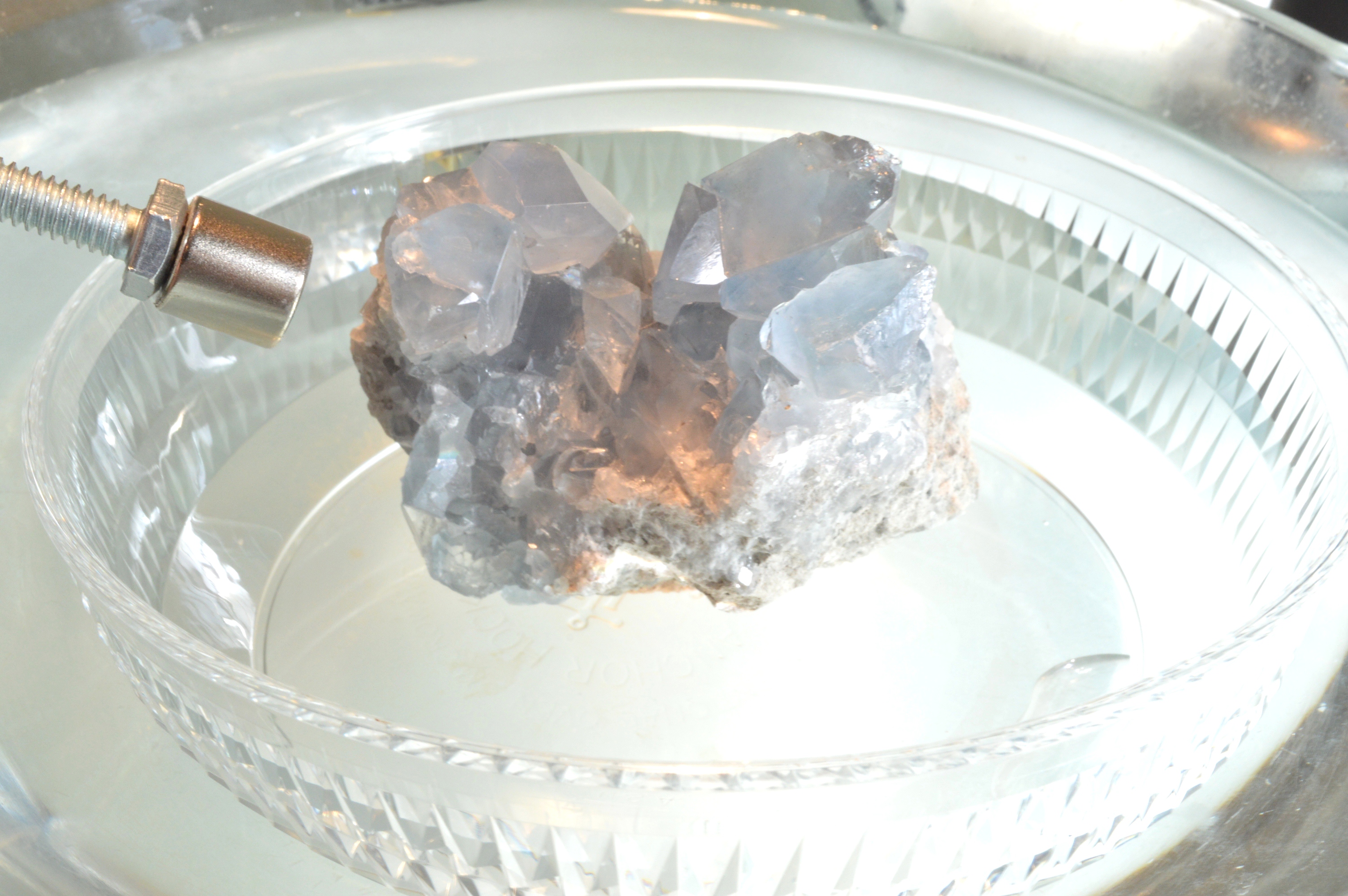 Testing Mineral Specimens: Large mineral specimens of any type can be tested for magnetic response via the floatation method if we place the specimens inside a large plastic tub or lid that is floated in water. Without floatation, specimens of rough crystals embedded in heavy host rock or matrix cannot show a response when a magnet is applied. But when the entire specimen is floated, we can hold an N52 neodymium magnet near individual crystals or clusters of crystals to test for magnetic response. With this method, Garnets do not pick up, but instead show strong attraction (with the exception of Grossular Garnets, which show weak attraction).
Testing Mineral Specimens: Large mineral specimens of any type can be tested for magnetic response via the floatation method if we place the specimens inside a large plastic tub or lid that is floated in water. Without floatation, specimens of rough crystals embedded in heavy host rock or matrix cannot show a response when a magnet is applied. But when the entire specimen is floated, we can hold an N52 neodymium magnet near individual crystals or clusters of crystals to test for magnetic response. With this method, Garnets do not pick up, but instead show strong attraction (with the exception of Grossular Garnets, which show weak attraction).
Floating a Mineral Specimen
of Chrysocolla
Magnetic Wand
10 Practical Uses for Gem Identification
Natural Opal (Inert) &
Synthetic Opal (Inert)
Other than a Pinpoint Magnetic Wand, two other helpful gem identification tools that can be handy for testing gems set in jewelry are a UV flashlight to test for fluorescence, and a Thermal Conductivity Meter to test individual gems for heat conduction.
Newer on the gem market are specialty Glass-ceramics such as Nanosital, Monosital and Siamite. These are trade names for a Russian-made gem Glass with higher refractive index, brilliance and hardness than standard Glass due to the addition of yttrium and aluminum. We have found that manufacturers of Nanosital Glass use rare-earth metals such as erbium in a number of colors such as pink, purple, bluish purple and even yellow, resulting in a variety of gem colors that show Drag responses. We also found a light green Nanosital gem containing iron and a dark green Siamite gem containing cobalt that show weak magnetic responses.
Nanostial Glass Gems that Show Magnetic Attraction
An exception is Chrysoprase Chalcedony. With the help of a magnetic wand, colorless Chalcedony that has been dyed green to look like Chrysoprase can easily be distinguished from genuine Chrysoprase. Genuine Chrysoprase gems, except for some very near-colorless examples, show some degree of magnetic attraction when floated due to microscopic inclusions that contain nickel. Chalcedony gems that have been made to look like Chrysoprase by the application of artificial green dyes are diamagnetic.
Chrysoprase (Strong) & Dyed Green Chalcedony (Inert)
An example of dyed green chalcedony imitating a different type of gem is chalcedony that has been dyed dark green to look like green Jadeite Jade or green Nephrite Jade. Genuine green Jade always contains enough iron to cause some magnetic attraction when floated. Dark green Nephrite may even show a Drag response without the need for floatation. In contrast, dyed chalcedony gems are always diamagnetic.
Jadeite (Weak) & Dyed Green Chalcedony (Inert)
Another reader reports she has scanned alluvial (river) sand and gravel with a magnet to separate fine grains of magnetic Garnet from the inert grains of gravel (Quartz and Feldspar).
Separating Garnets from River Gravel from British Columbia, Canada
Glass/Garnet Doublet
Pavilion is Inert, Crown Side Drags
Natural Untreated Turquoise (Moderate)
Chrysoprase Ring (Moderate)


